Sun-hardened wood, sleek synthetics, and even living greenery now compete for space underfoot, making 2025 a banner year for creative deck flooring. From classic pressure-treated planks to porcelain pavers set on adjustable pedestals, today’s options balance style, durability, and maintenance like never before. Leveraging recycled content, heat-scattering technology, and eye-catching patterns, you can match any budget or climate while turning a simple platform into an open-air room that feels unmistakably yours. The 25 ideas below move from familiar lumber to ambitious mixed-material combos, each backed by solid advice and an actionable twist so you can start planning the surface that will carry every barefoot barbecue and late-night star-gazing session to come.
1. Pressure-Treated Pine Deck Planks for Budget-Friendly Strength
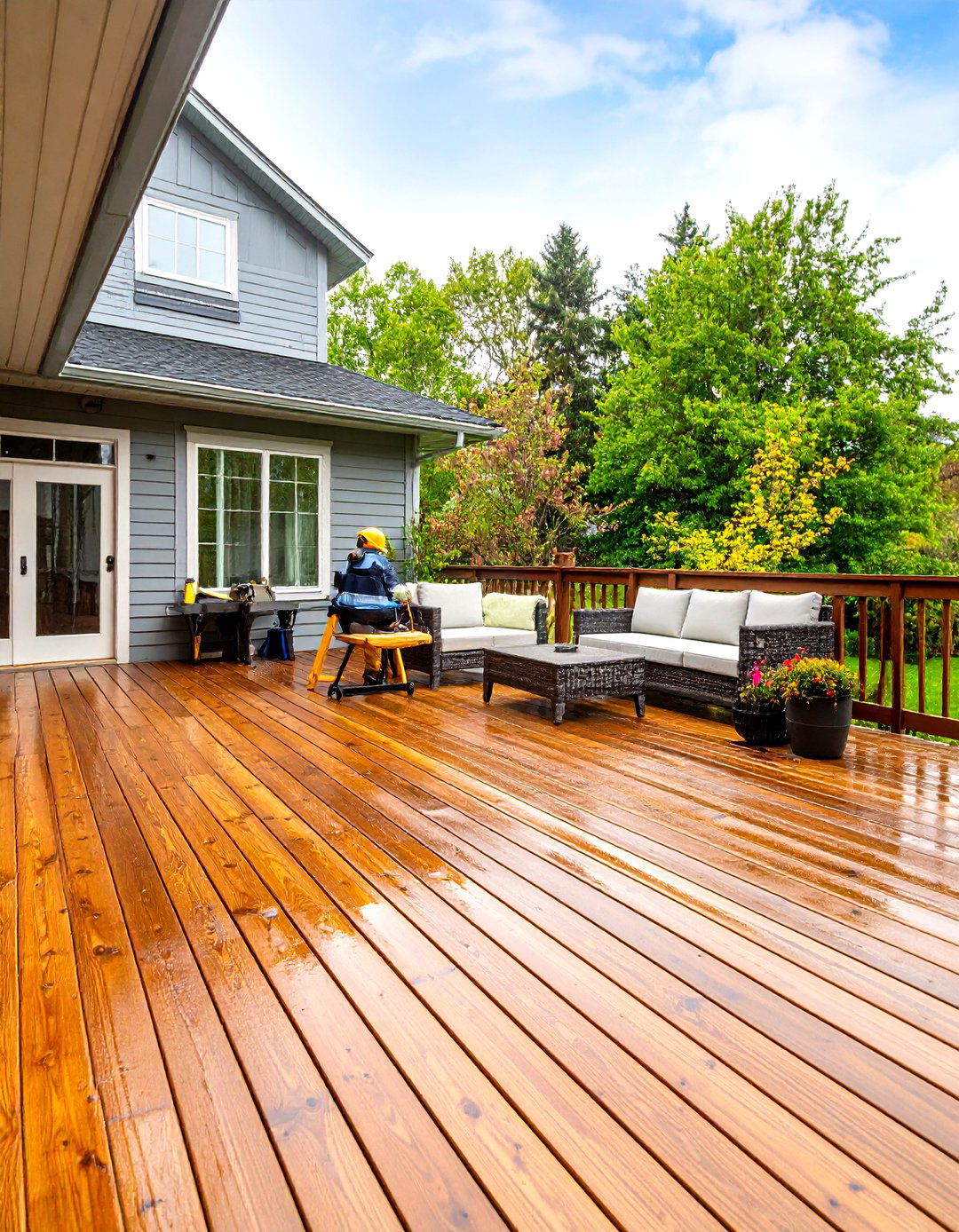
A thrifty yet rugged foundation, pressure-treated pine is chemically fortified to resist insects and rot, giving new deck flooring a fighting chance against humidity and errant sprinklers. Proper sealing and seasonal cleaning help the boards last far beyond their price tag, and easy availability at home-centers means quick weekend sourcing. Because pine accepts stains readily after a short weathering period, you can shift its color palette as trends evolve. Just remember to wear a mask when cutting to avoid inhaling treatment residue, and collect off-cuts for safe disposal instead of that tempting bonfire.
2. Naturally Rot-Resistant Cedar Deck Boards

The honey-toned heartwood of cedar carries built-in tannins that fend off decay and bugs without chemicals, letting eco-minded owners keep deck flooring maintenance to gentle washing and a once-a-year clear coat. Lightweight boards make DIY installation friendlier than many hardwoods, yet the wood’s tight grain keeps splitting to a minimum. Over time it weathers to a silvery gray that complements coastal or modern cabins; a semi-transparent stain will pause the patina if you prefer that fresh-milled glow. Plan yearly light sanding to knock down any raised fibers and you’ll extend its service life admirably.
3. Redwood Deck Flooring That Ages Gracefully
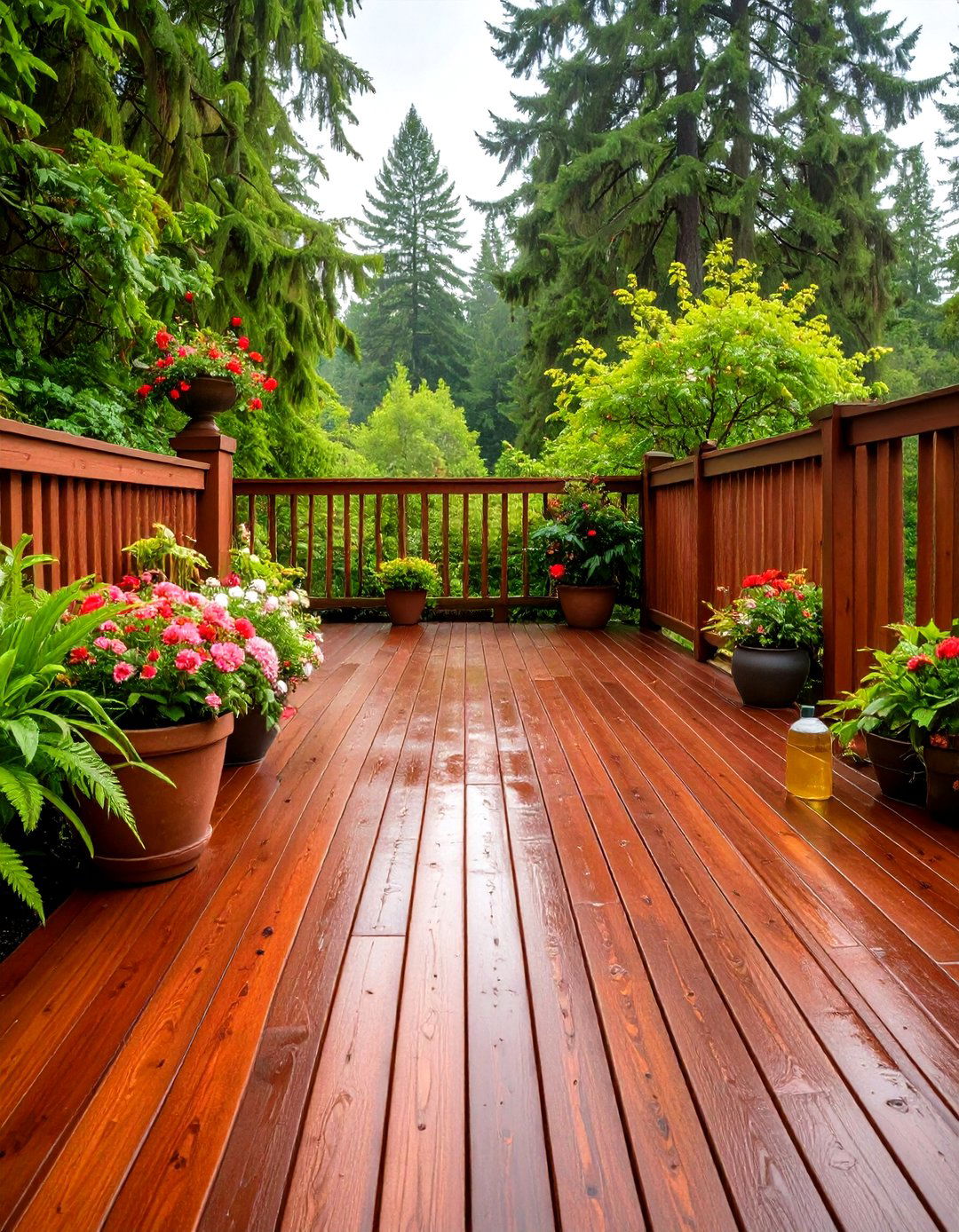
Redwood’s fine grain and natural oils give deck flooring a rich, warm hue that resists warping even in damp climates. Because the lumber grows predominantly on the U. S. West Coast, sourcing certified stock supports sustainable forestry practices while trimming transport miles for Pacific homeowners. Early spring cleaning with a soft brush and oxalic acid brightener keeps tannin stains at bay, and a penetrating oil finish every few years refreshes color without forming a flaky film. Although initial costs beat cedar, many buyers consider redwood’s dimensional stability and barefoot-friendly texture worth the splurge.
4. Tropical Hardwood Ipe for Extreme Durability
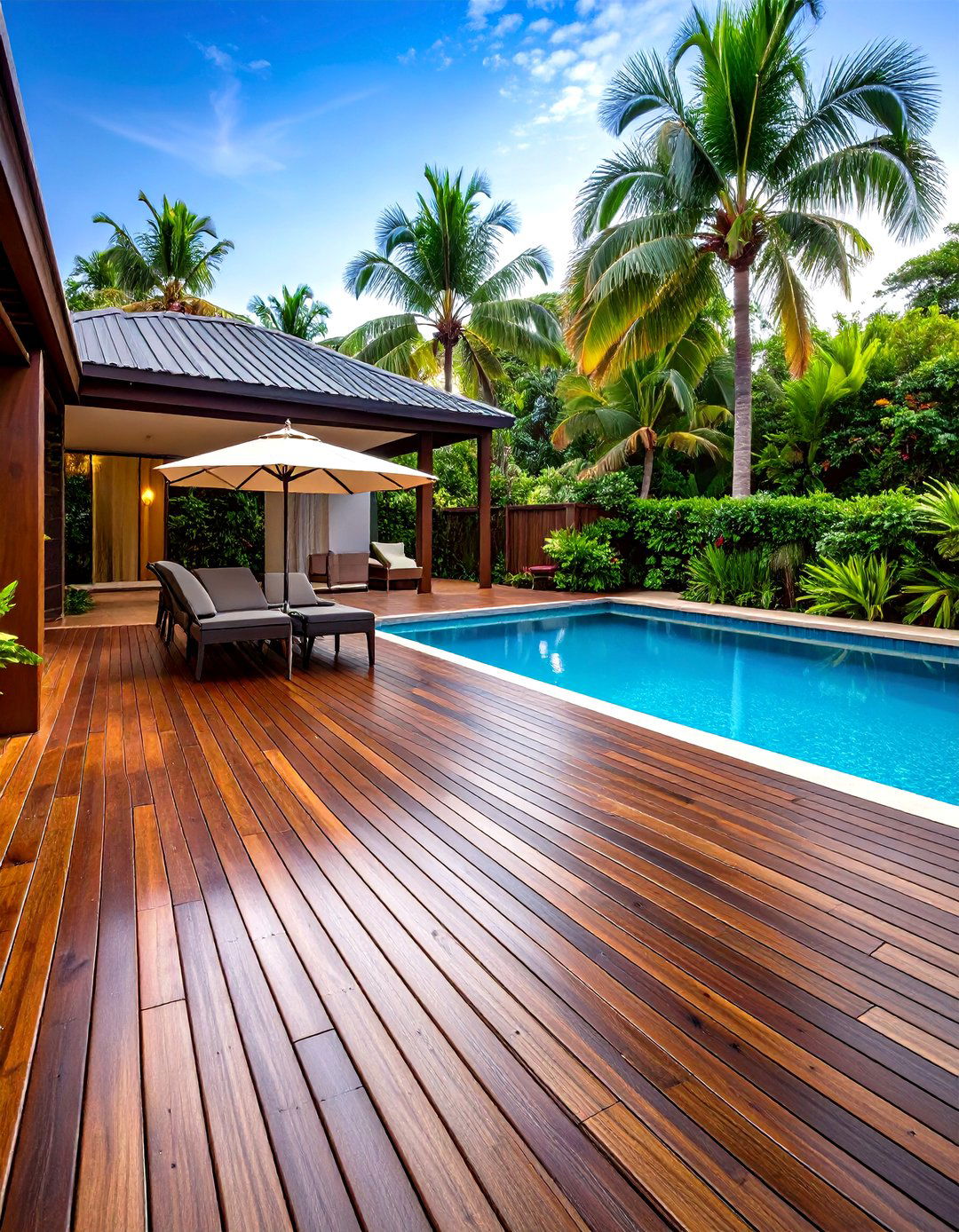
Dense enough to sink in water, ipe (Brazilian walnut) shrugs off termites, mildew, and spinning patio chairs, giving deck flooring a 40-plus-year expectation with minimal upkeep. Be prepared: pre-drilling is mandatory and carbide blades dull quickly, so labor costs rise. A yearly wipe of UV oil preserves its chocolate color; skip the oil and it fades to elegant silver. Ethical sourcing matters — look for FSC certification to avoid contributing to deforestation. Pair ipe with hidden fasteners to showcase its seamless grain and you’ll have a high-end platform rivaling boutique resort boardwalks.
5. Maintenance-Saving Composite Deck Boards

Composite planks blend recycled plastic with wood fibers, creating deck flooring that resists rot, splintering, and color fade while echoing natural grain. Encapsulated “capped” versions offer extra stain defense, ideal for ketchup-prone grilling zones. A bucket of soapy water is usually all the upkeep required, freeing weekends once lost to sanding. Composites also arrive in cool-touch formulas that mitigate foot scorch on full-sun rooftops. With grain patterns and multi-tonal streaking now mimicking tropical hardwoods, homeowners gain the upscale look without the harvesting concerns or annual oiling routine.
6. UV-Defying PVC Deck Surfaces

Owing to its 100 percent synthetic makeup, PVC decking laughs off moisture, termites, and mildew while boasting fade warranties of 25 – 50 years — perfect for decks that bake all afternoon. Lighter weight makes the boards easier to haul up apartment stairwells, and built-in slip resistance keeps things safe around splashy kiddie pools. While color ranges are narrower than composite, subtle embossing and matte finishes have shed the plastic sheen early vinyl once carried. Because expansion rates rise in hot climates, follow manufacturer spacing charts carefully to prevent summertime “board creep. ”
7. Cool-to-Touch Aluminum Deck Flooring
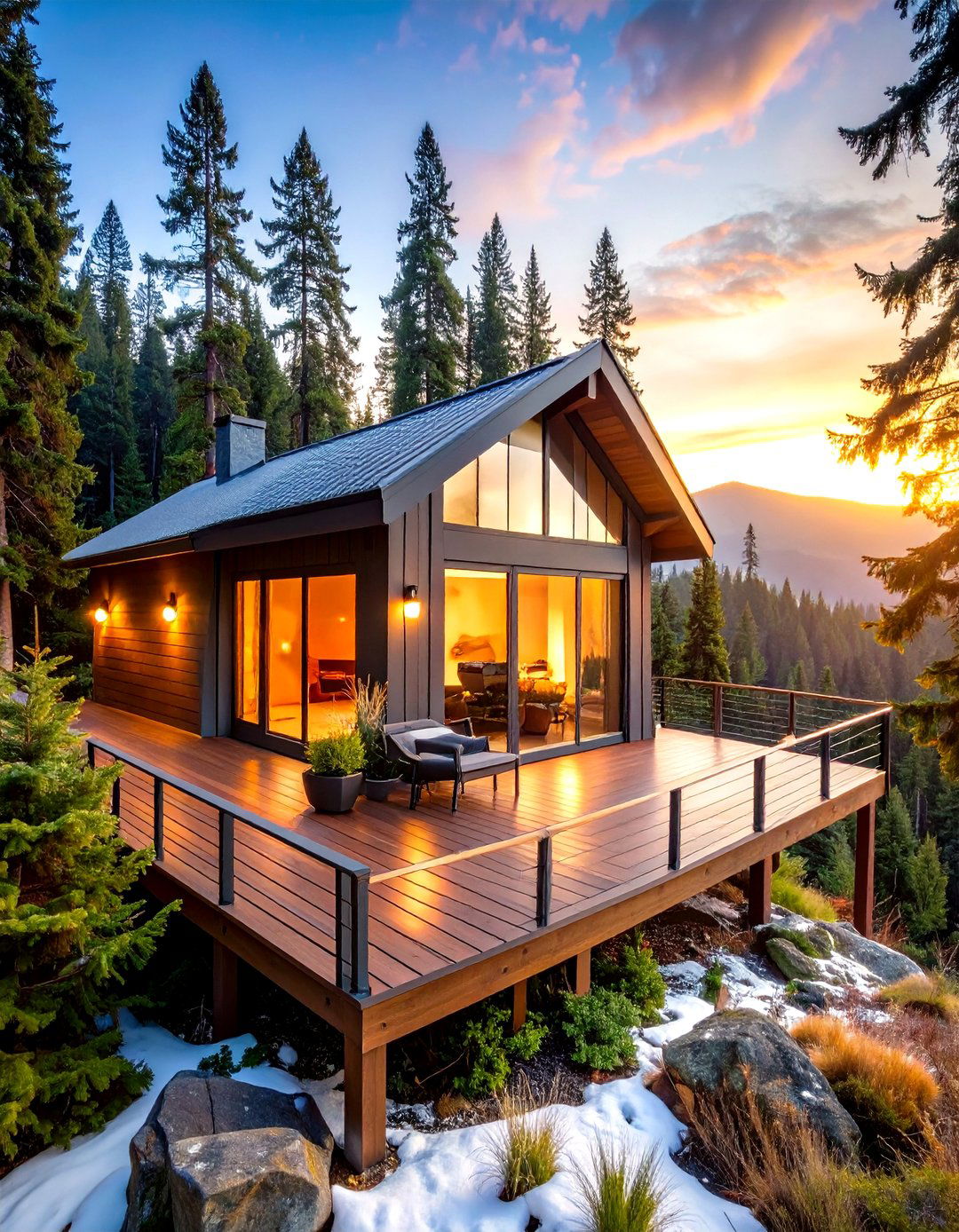
Surprisingly stylish powder-coat finishes and a polyurea top layer give modern aluminum planks wood-like looks, scratch resistance, and decades of zero-rot performance. Fire-proof and fully recyclable, they’re an insurance-friendly pick in wildfire zones. Integrated drainage channels double as a dry-storage ceiling for the patio below, and snow slides off easily, reducing winter shoveling. Expect premium pricing, but factor in the near absence of refinishing costs over its 50-year lifespan. When midday temperatures soar, throw down an outdoor rug or keep sandals handy — metal still conducts heat.
8. Renewable Bamboo Deck Planks
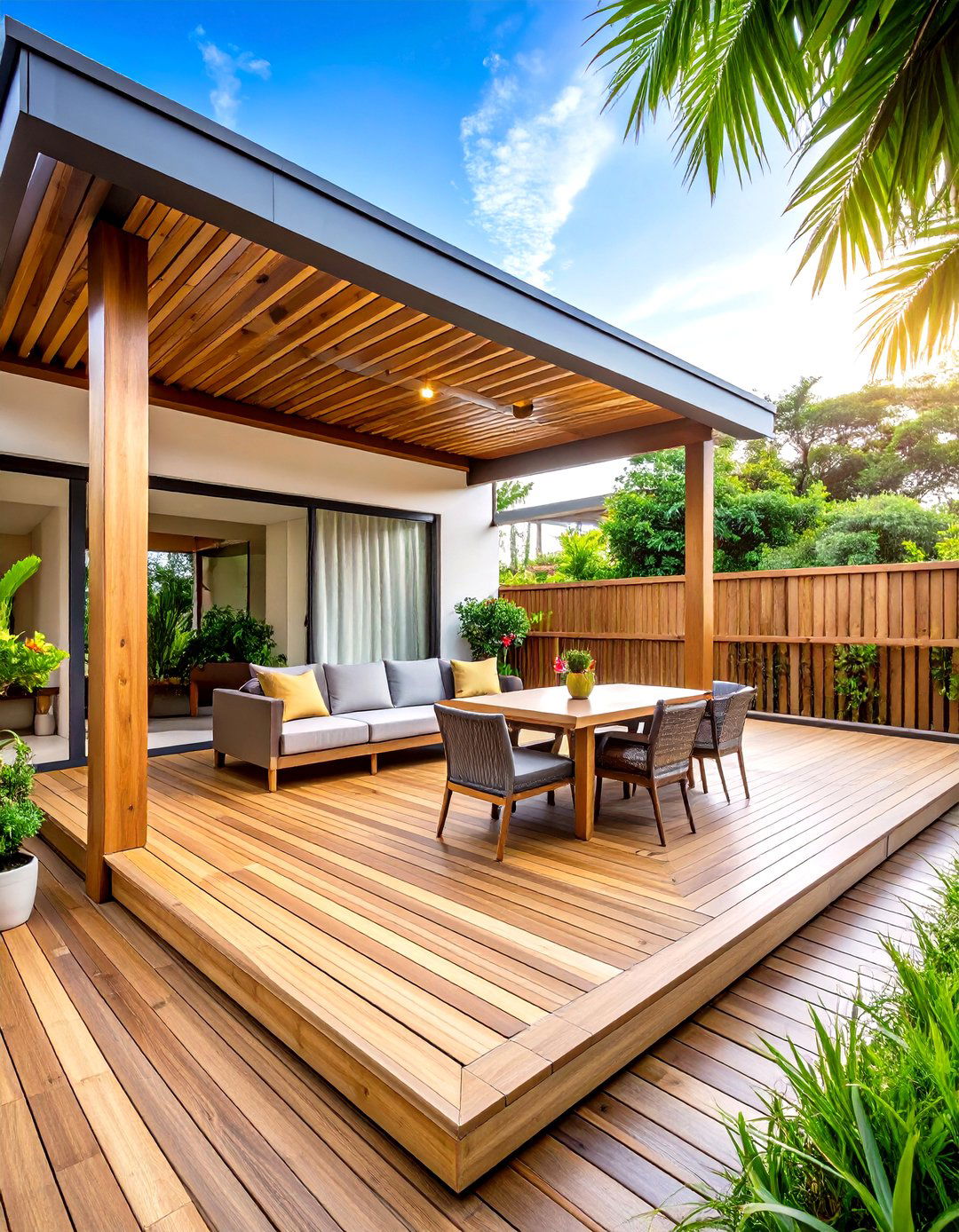
Unlike hardwood trees, bamboo reaches harvest maturity in about five years, letting you lay deck flooring that sequesters carbon quickly while delivering strength on par with ipe. Heat-compressed strand boards resist insects and surface checking, and many brands fuse recycled plastic into the mix for added moisture protection. Because bamboo fibers crave oxygen, edges should be sealed promptly after cuts. Annual oiling keeps color uniform, yet even weather-worn bamboo maintains its structural integrity. Look for products labeled “thermally modified” for extra dimensional stability in humid monsoon seasons.
9. Stone Deck Pavers on Adjustable Pedestals
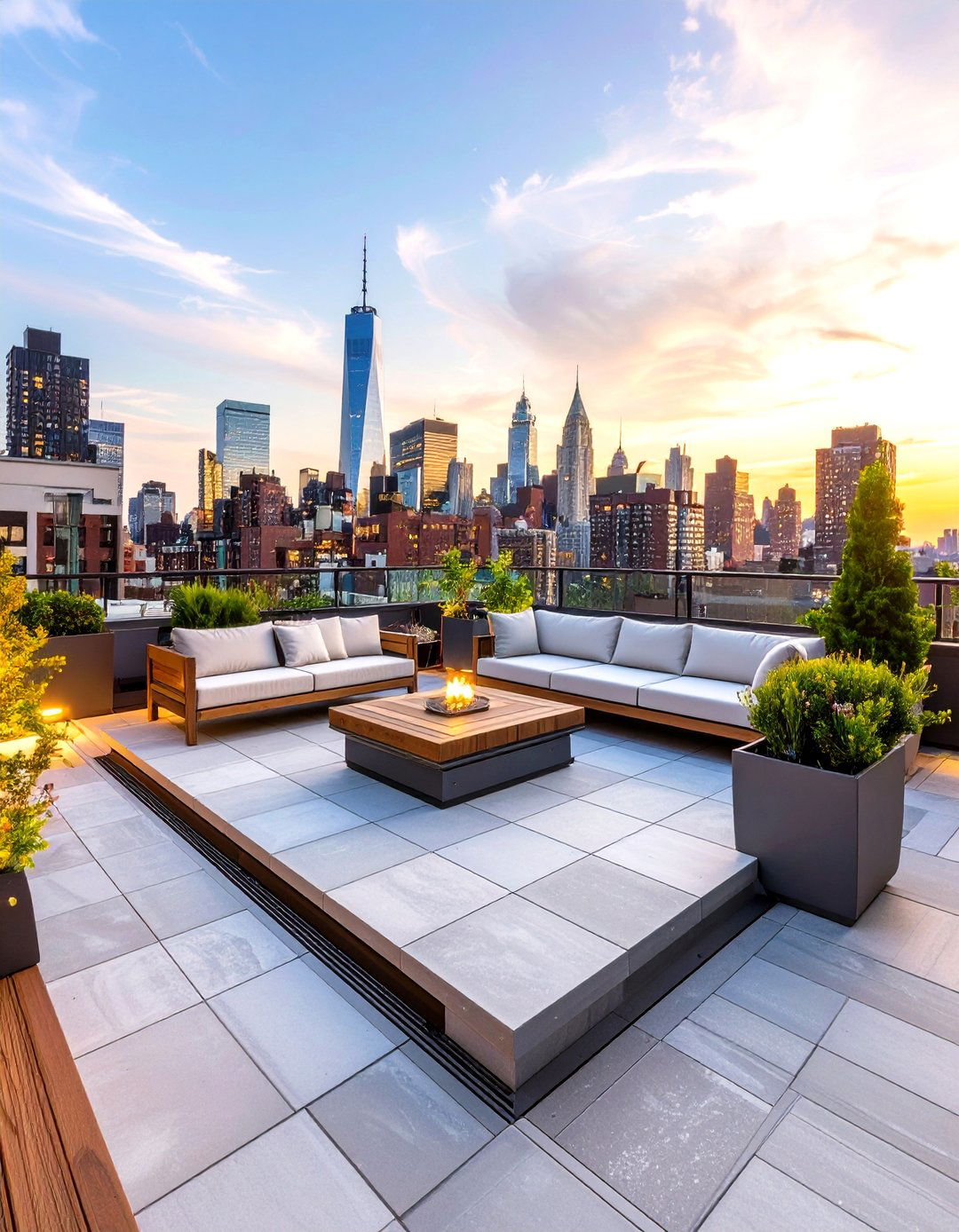
Installing porcelain-faced or natural-stone slabs atop adjustable plastic pedestals transforms a basic frame into a luxury terrace with hidden drainage and perfectly level deck flooring. The system keeps heavy pavers off joists, preventing moisture traps and allowing electrical runs beneath. Texture-rich limestone or slate updates older timber railings instantly, while frost-resistant porcelain weighs less and cleans with a quick mop. Replacement is as simple as lifting a single tile — handy for future wiring tweaks or style swaps. Because weight loads climb, verify beam span capacity before embracing this upscale finish.
10. Porcelain Paver Tiles for Sleek Style
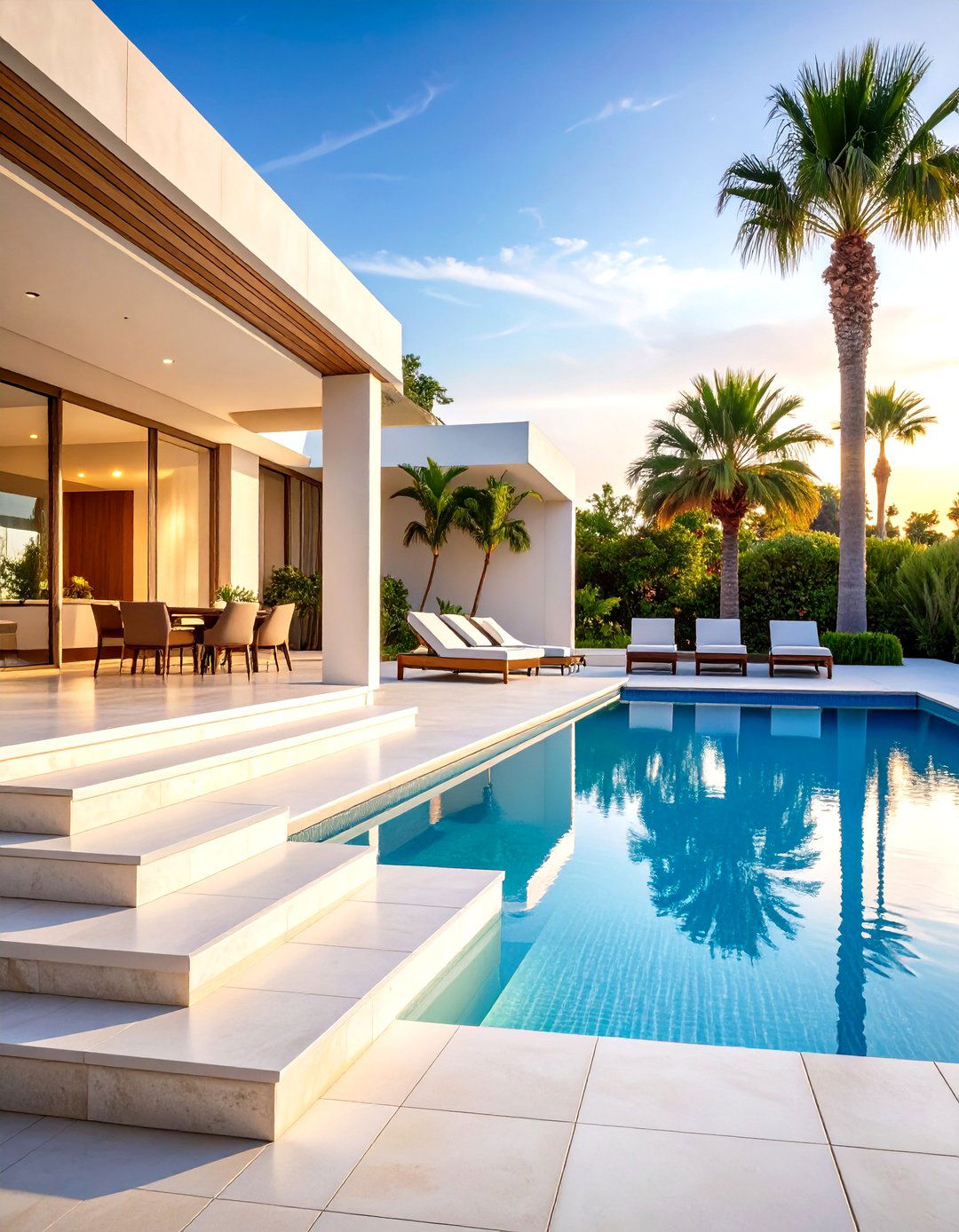
White-toned porcelain pavers mimic marble without the maintenance, giving deck flooring a resort feel that stays cool underfoot and shrugs off pool chemicals. Each tile is calibrated, so grout lines remain razor-thin, and slip-rated finishes tame soggy swimsuit traffic. Pair large 24-inch squares with matching stair treads for a seamless indoor-outdoor transition. Although porcelain can crack under point loads, pedestal systems or a concrete base provide uniform support. Periodic pressure washing clears the micropores of grime, but staining is rare thanks to vitrified surfaces fired above 1, 200 °C.
11. Decorative Concrete Overlay Resurfacing
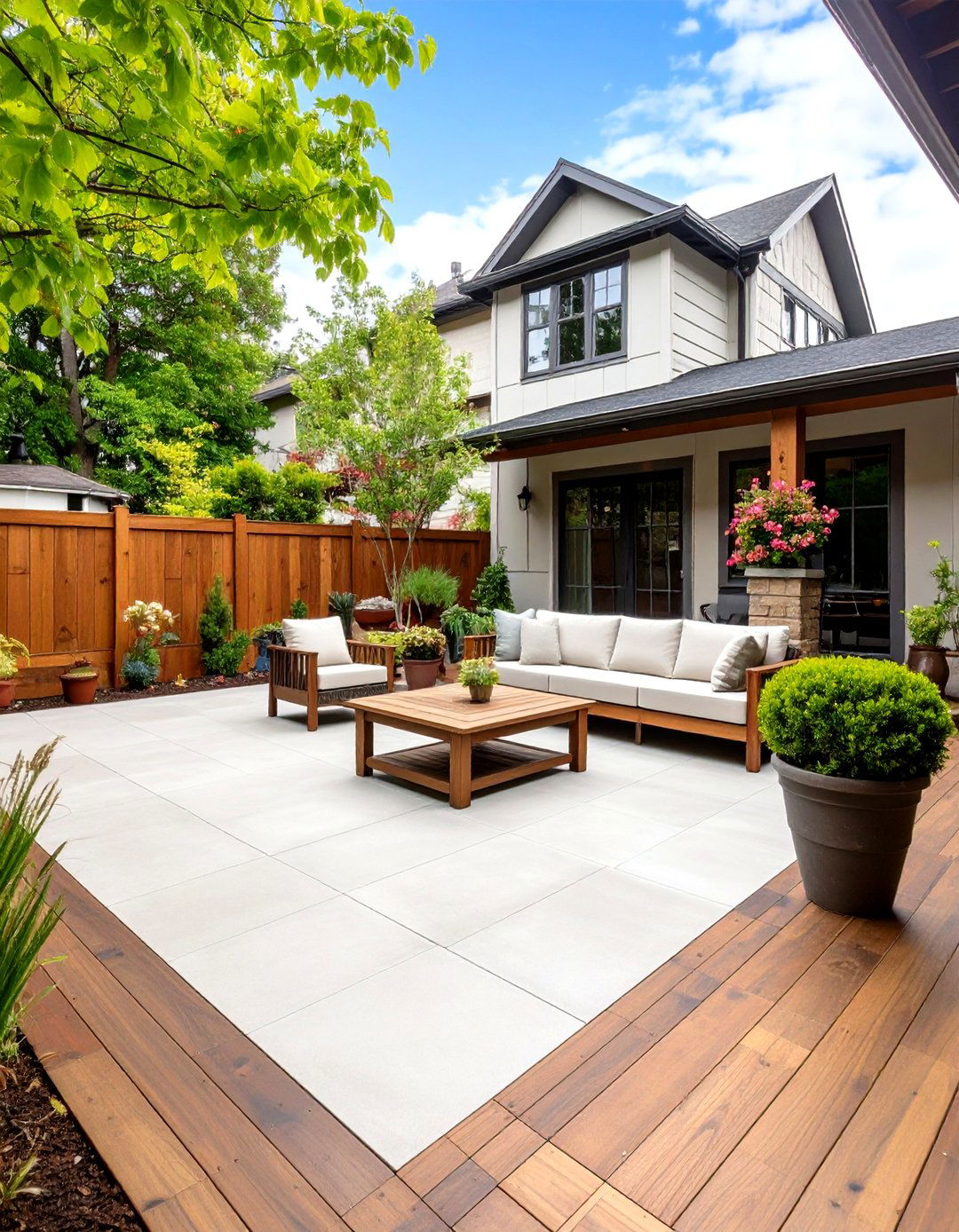
Rather than ripping out a tired slab, a polymer-modified overlay spreads a fresh ⅛-inch skin that can be broom-finished, stamped, or dyed to imitate anything from weathered barnwood to Italian travertine. At roughly $6 per square foot, it’s budget friendly compared with full replacement and adds only minimal height, so door thresholds stay intact. Because the new layer bonds chemically, good prep — pressure washing, patching, and priming — matters more than fancy tools. Finish with a breathable sealer every few years to lock out freeze-thaw damage and barbecue grease.
12. Impact-Absorbing Rubber Paver Deck

If kids cannonball off railings or your knees prefer forgiving footing, recycled-tire rubber pavers click together over existing surfaces, cushioning impact while resisting slipping even when soaked. Faux-flagstone textures and earth-tone pigments disguise the material’s sporty origins, and built-in channels help water drain quickly. Rubber stays cooler than composite under blazing sun, plus its non-porous surface surrenders dirt with a hose. Edge pieces trim neatly with a sharp knife, making it a true evening DIY. Just check local fire codes, as some jurisdictions restrict rubber near grill stations.
13. Interlocking Wood Deck Tiles for Quick Makeovers
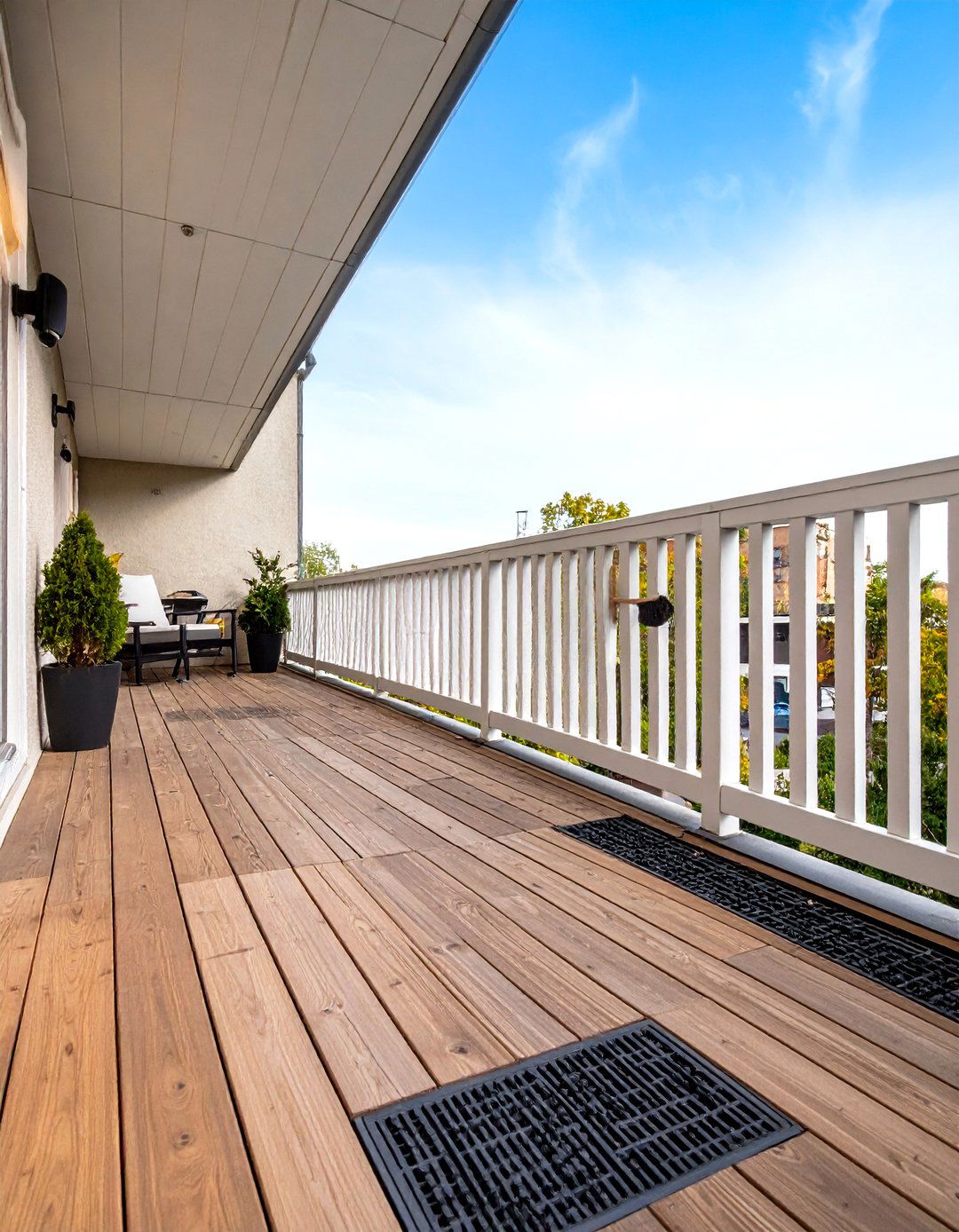
Looking to refresh a condo balcony before guests arrive? Snap-together acacia or ipe deck tiles lay directly over concrete, covering hairline cracks with warm grain in under an hour. Built-in plastic grids lift the wood so rain can escape, and individual tiles lift out for seasonal cleaning — or moving day. Mix orientations to craft checkerboard patterns without cutting, and replace a single damaged square instead of tearing up whole boards. Apply a light deck oil annually to maintain golden tones; otherwise, embrace a uniform silver patina after just one season outdoors.
14. Snap-Together PVC Deck Tiles on Balconies
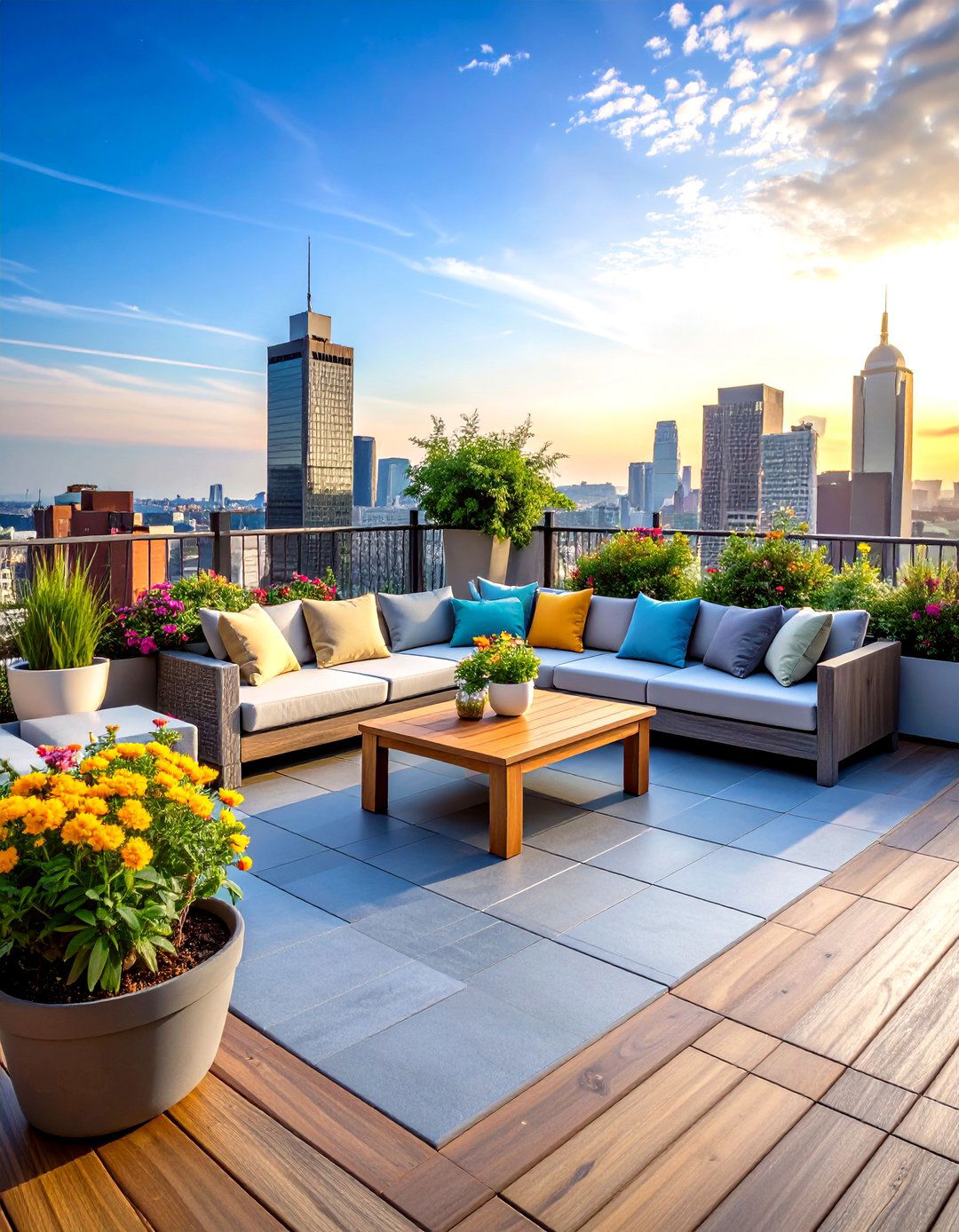
Plastic interlocking squares deliver drainage, mildew immunity, and vibrant color options — think slate gray or marine blue — without splinters, making children’s play corners safer. They flex slightly to absorb chair scuffs and roll up for mid-summer deep cleaning. Because the tiles are thin and lightweight, high-rise installations rarely need structural approval, yet they still mask puddling floors. Pair solid-colored tiles with accent borders to define seating areas, and store a spare carton for effortless future patch jobs. A mild detergent mop restores factory finish; skip harsh solvents that could dull UV inhibitors.
15. Artificial Turf Panels for a Soft Green Deck
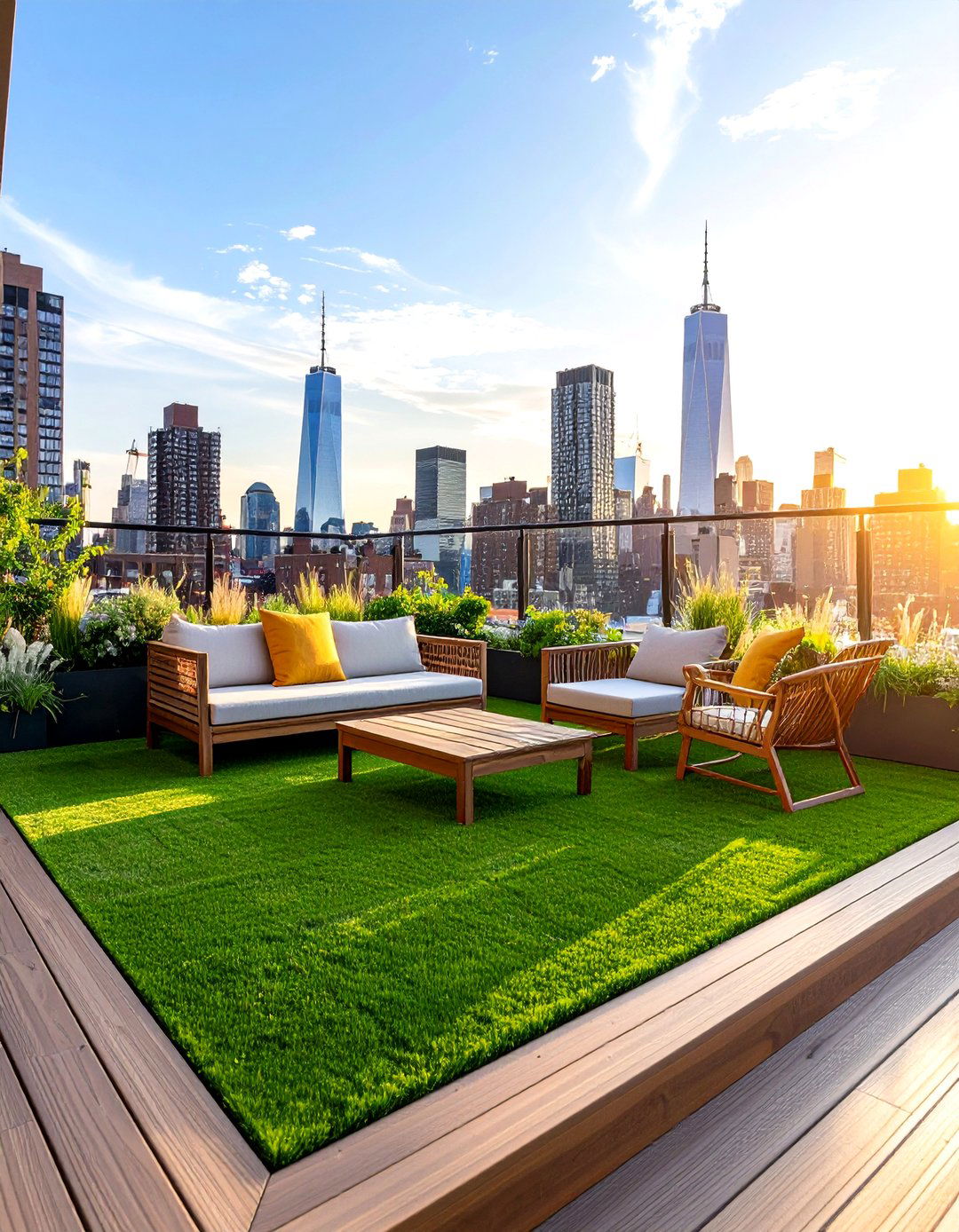
Creating an urban backyard vibe up on the roof is easy with UV-stable synthetic turf panels that Velcro or snap onto underlayment grids, turning deck flooring into picnic-ready “lawn. ” Perforated backing drains storm water, and antimicrobial infill limits kennel odors if pets tag along. Choose short ¾-inch pile for chairs that need firm footing, or plush 1½-inch for barefoot lounging. Quarterly brooming lifts crushed blades, while an occasional hose-down sweeps away dust. Because turf weighs less than stone, it suits weight-restricted rooftops where real sod would be impossible.
16. Weatherproof Outdoor Carpet and Rugs
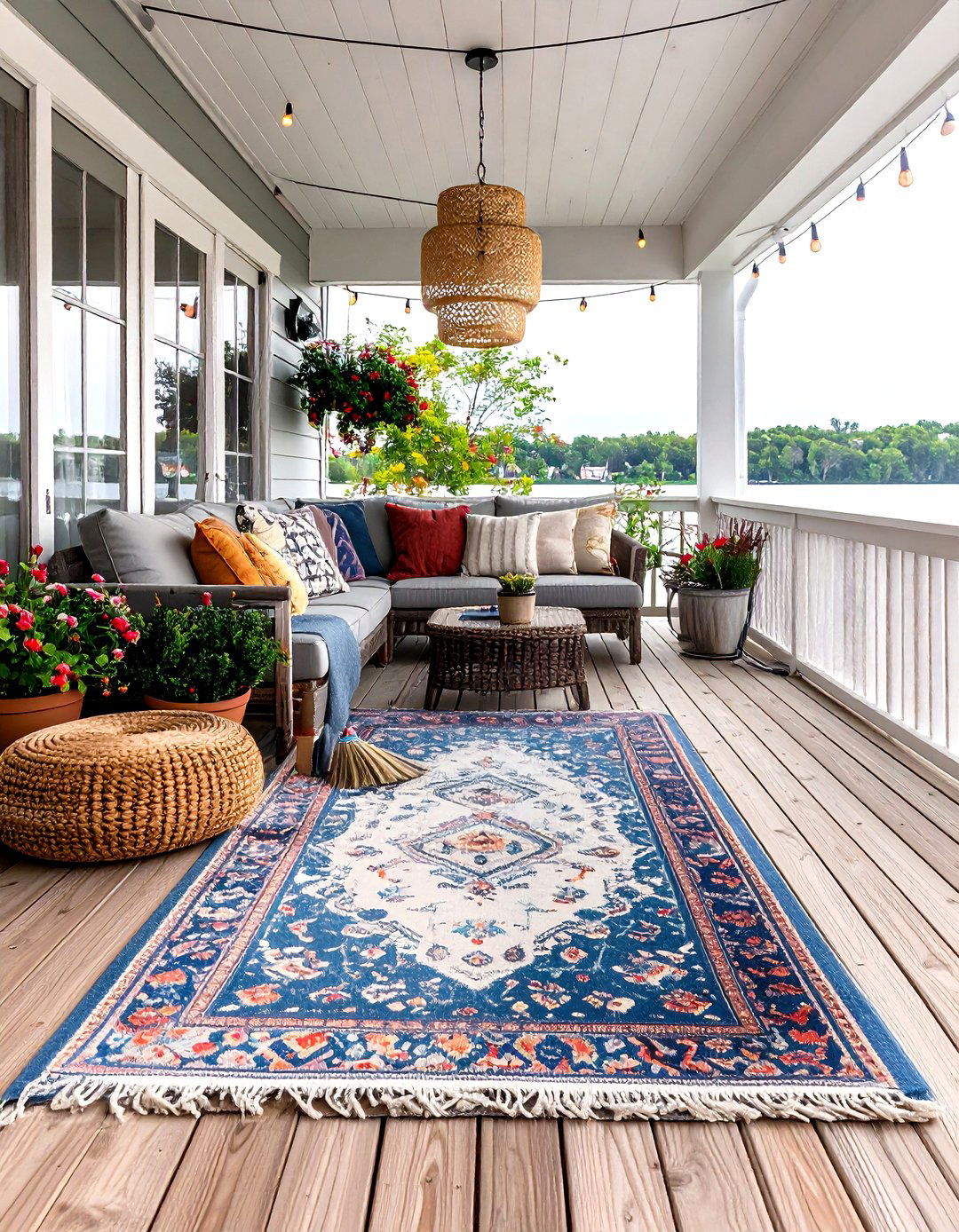
Layering polypropylene rugs or full-width marine carpet tames echoing concrete and warms composite boards, adding pattern without the permanence of paint. Look for solution-dyed fibers that shrug off UV rays and wick away rain, then sweep weekly to stop dirt from embedding. Twice-annual deep cleans — mild soap, hose, and thorough air-dry — keep mildew at bay. Matching stair treads add slip resistance on narrow steps, and carpet tape secures edges against tripping. When style trends change, simply roll up yesterday’s geometry and unroll a fresh palette in minutes.
17. Diagonal Board Layout to Enlarge Space
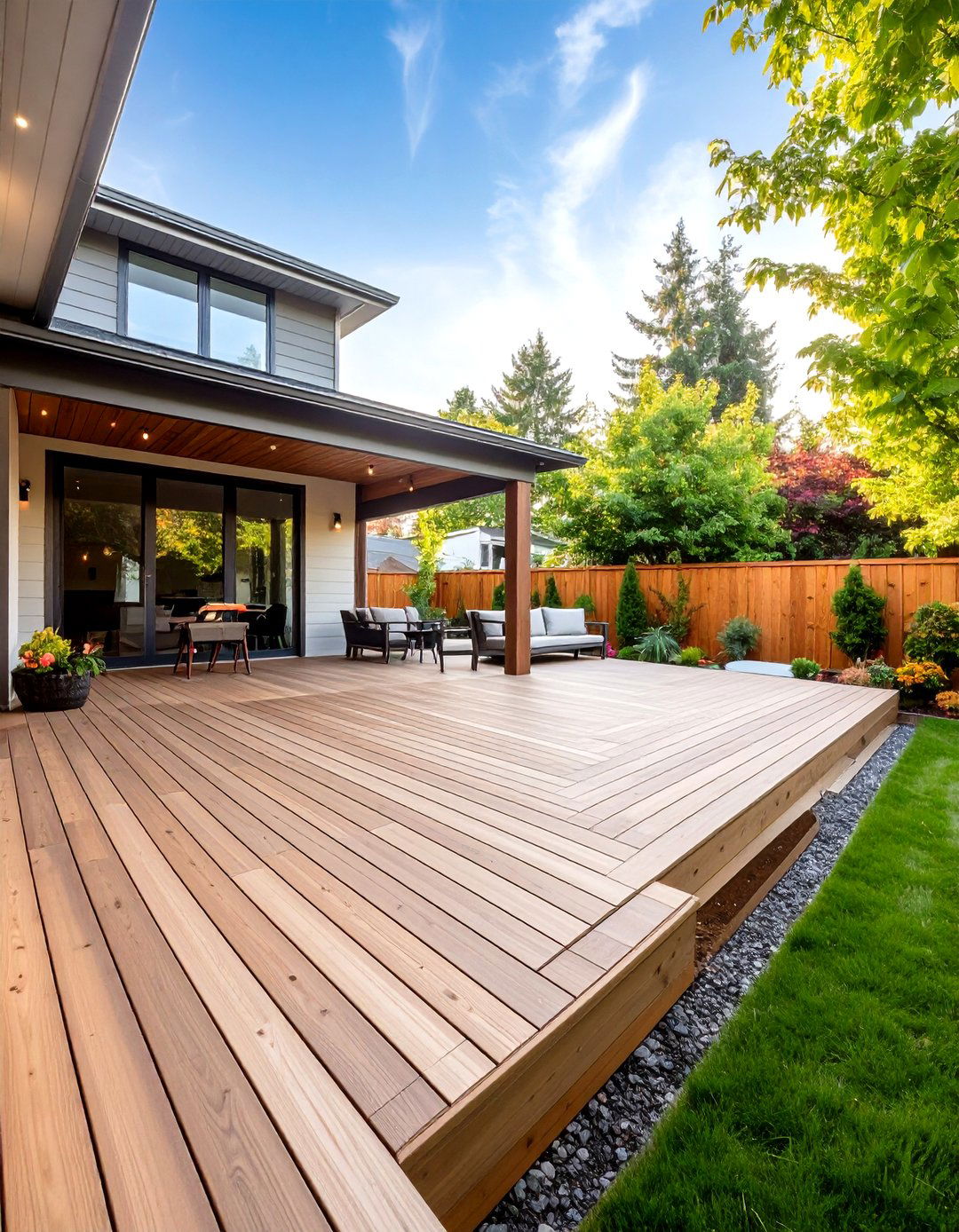
Unlike straightforward parallel planks, a 45-degree layout draws the eye outward, making compact deck flooring feel roomier while adding lateral stiffness that helps distribute weight. Expect about 15 percent more board-foot due to longer angled cuts, but the payoff is structural bracing and visual energy. Frame blocking must accompany every diagonal seam, so note the extra labor in the budget. Finish boards with darker picture-frame edges to emphasize directionality, and you’ll earn compliments for a pattern that looks complex yet revolves around a simple miter saw setting.
18. Herringbone Pattern for Visual Drama

With its zig-zag “V” geometry borrowed from parquet floors, a herringbone layout turns deck flooring into living art and naturally zones separate lounging and dining pockets. Because each board end rests on doubled joists, hire a pro or beef up blocking if DIYing. Contrasting board widths — say, a narrow tan paired with a wider mocha — add even greater depth. Keep debris from lodging in the tighter seams with periodic leaf-blower passes, and plan an annual deep clean to deter algae that might hide in those stylish grooves.
19. Picture-Frame Borders That Define Zones
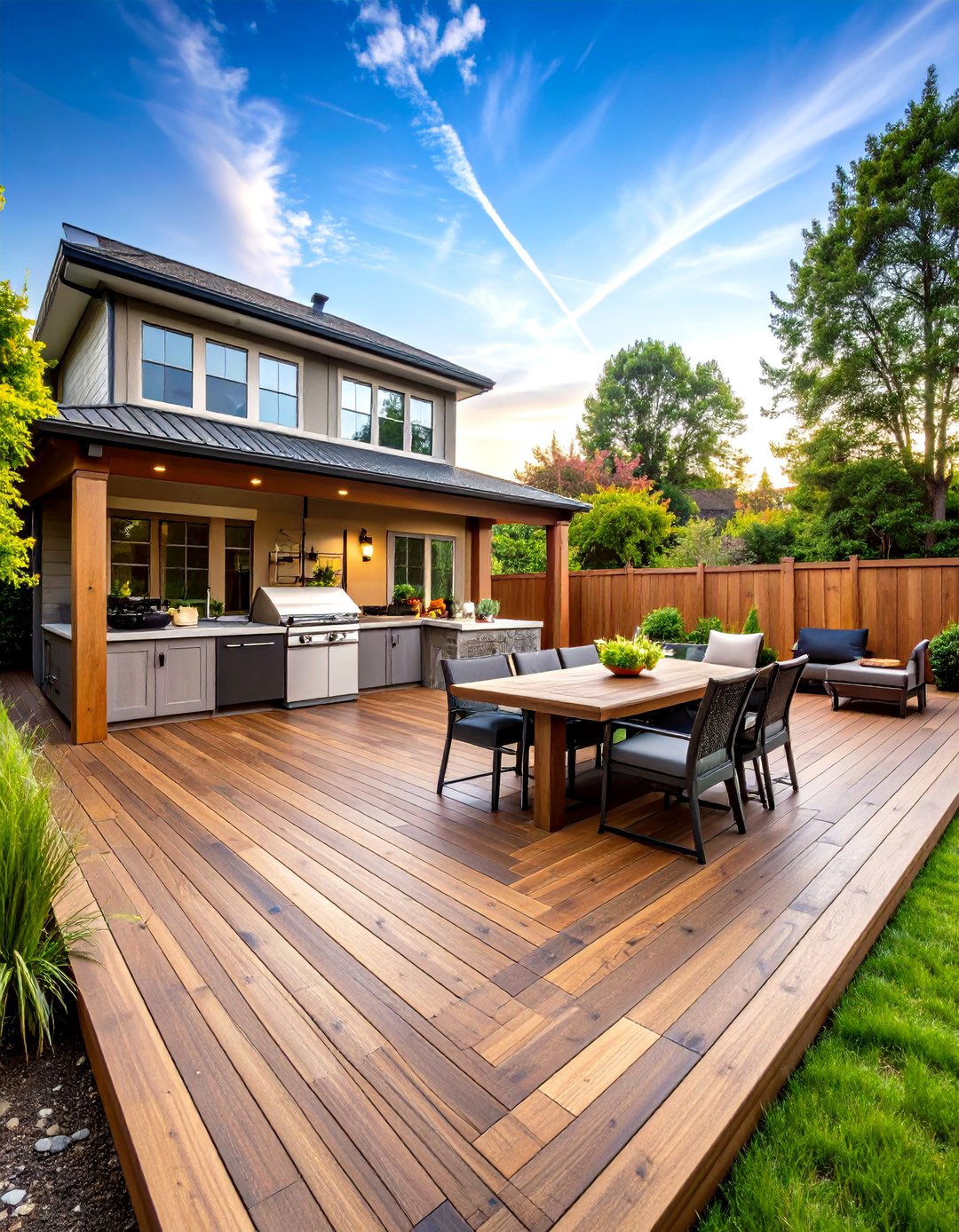
Running a darker “picture-frame” board around the deck’s perimeter hides end grain, seals vulnerable cuts, and instantly elevates even budget planks into a finish that feels custom. Double joists support the border while allowing field boards to end cleanly against it, eliminating exposed center screws. Use the same technique to outline grill nooks or hot-tub areas, guiding foot traffic subconsciously. Because the frame grain runs perpendicular, slight color changes over time create a charming contrast without extra stain. Remember to gap border boards equally to maintain even expansion joints.
20. Two-Tone Color Blocking with Composite Planks

Certainly, mixing complementary composite hues — charcoal and driftwood, for example — lets deck flooring express personality while highlighting functional sections like dining platforms or walkway ribbons. Manufacturers offer boards from the same collection with identical embossing, so you gain bold contrast without mismatched textures. Hidden-clip fasteners keep the surface fastener-free, maintaining clean lines that make the color blocking pop. Use a darker shade in heavy traffic lanes to camouflage scuffs, and carry the accent color up the stair risers for a connected, designer finish worthy of magazine spreads.
21. Painted and Stenciled Deck Flooring
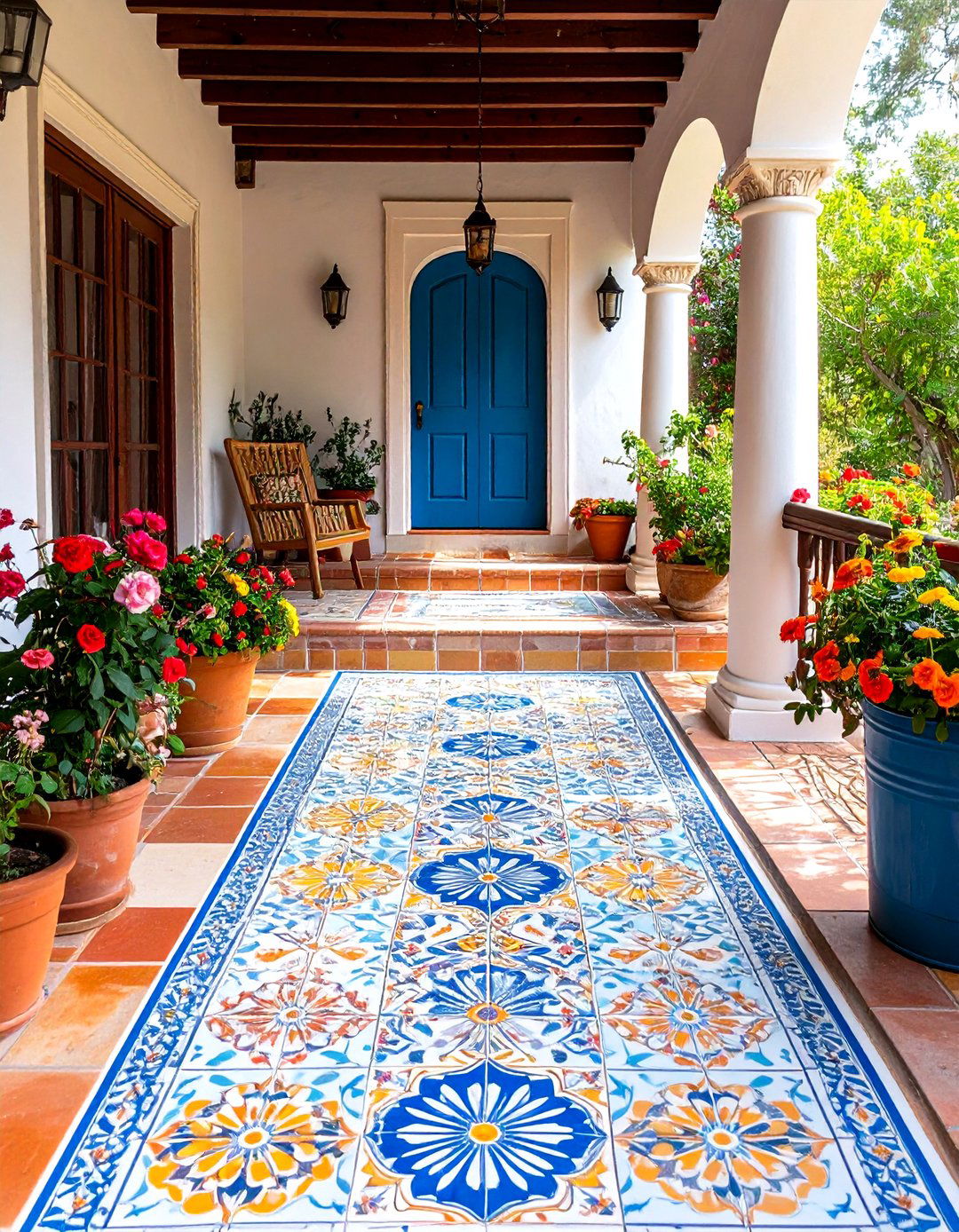
Bringing indoor artistry outside, high-quality porch paint topped with laser-cut stencils can mimic Moroccan tile or compass roses for under $100 and a weekend’s work. Start by scuff-sanding, then roll on a bonding primer and two coats of exterior latex. Secure the stencil with repositionable spray adhesive, dab lightly to avoid bleed-through, and seal with a matte urethane for weather armor. Touch-ups involve nothing more than dabbing fresh color through the stencil again. This trick suits both wood and concrete, giving renters an easily reversible style upgrade.
22. Reclaimed Pallet Wood for Eco-Chic Decks

Pallet boards salvaged from local warehouses or ReStore shops can form rustic deck flooring at near-zero material cost, provided you choose heat-treated stamps and pull every nail. Because lengths vary, frame joists closer together and pre-sort boards by thickness to avoid trip lips. Seal thoroughly — two coats of penetrating oil minimizes splinters and water uptake — and lay outdoor mats over high-traffic zones if the wood feels rough. While pallet decks likely won’t last decades, they excel as temporary platforms for renters or gardeners needing an instant perch.
23. Brick Paver Inlays for Classic Warmth
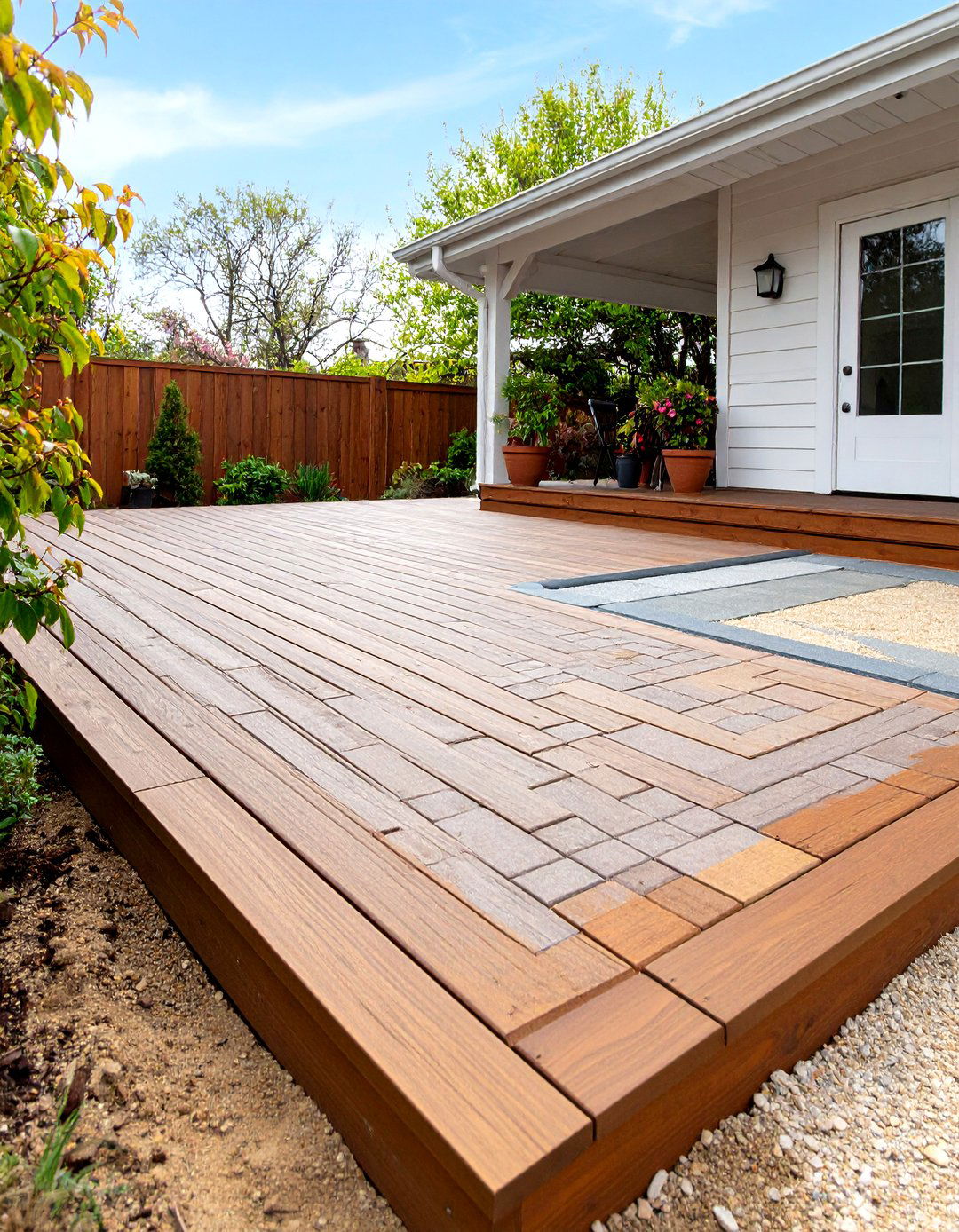
Looking for Old-World charm? Swap a central square of deck boards for modular brick pavers laid on a thin sand bed between joists, adding tactile interest and heat-absorbing mass that extends autumn evenings. Herringbone or basket-weave layouts contrast nicely with adjacent wood grain, and the pavers’ resilience to sparks makes them an ideal grill pad. A surrounding PVC or composite border holds pavers in place while blocking weed intrusion. Clear settling sand each spring and top up joints to maintain a stable, wobble-free surface.
24. Mixed Material Decks Combining Gravel and Pavers
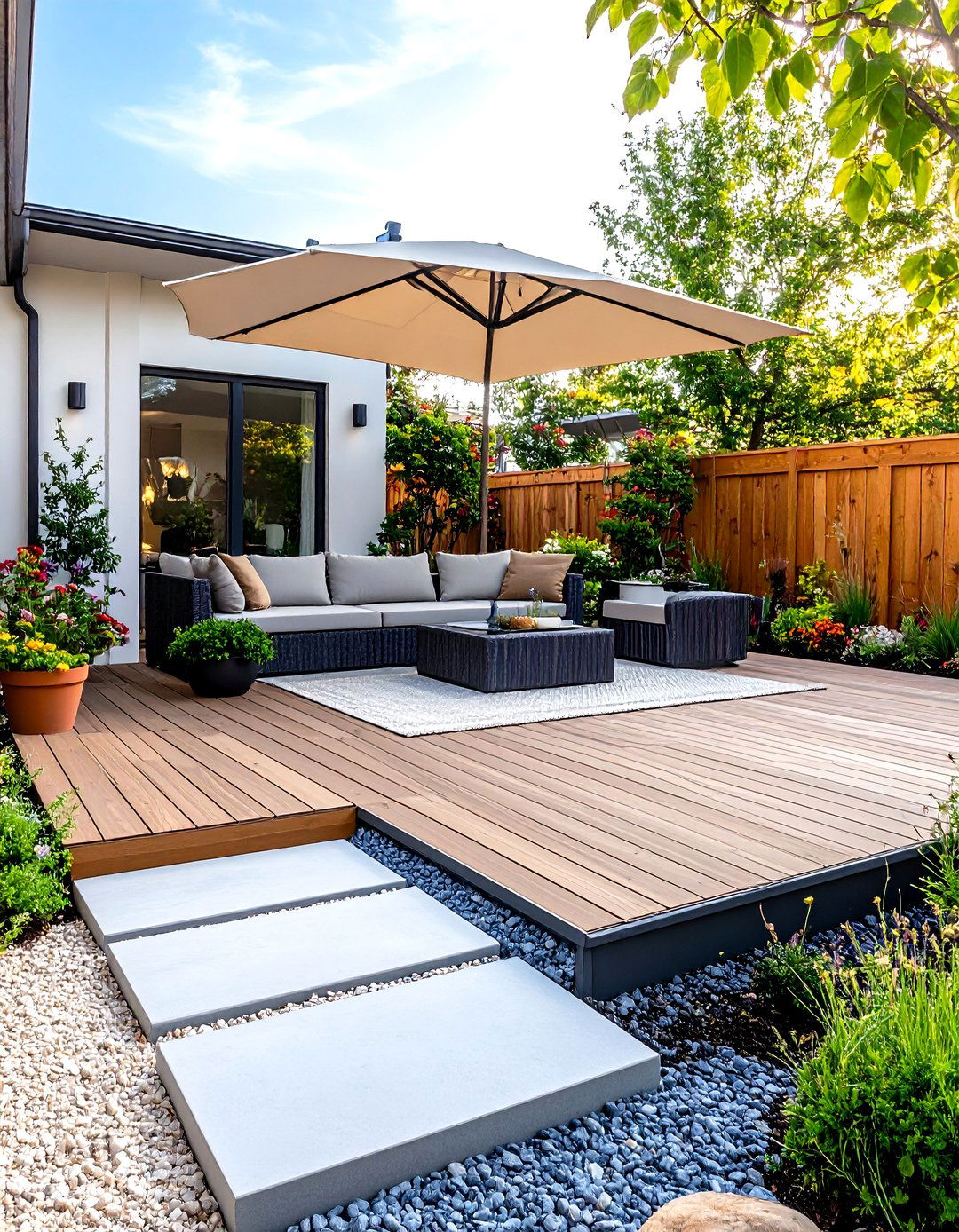
Rocks and concrete pavers team up to build low-maintenance “floor art” on ground-level decks: stepping-stone pavers form walking paths, while pea gravel fills voids, allowing rain to percolate naturally. Edging lumber or steel strips keep stones corralled, and a woven landscape fabric beneath curbs weeds. Layer outdoor rugs atop gravel for pop-up lounges that can shift as gatherings grow. Because the system weighs less than a solid slab, it’s kinder to expansive clay soils. Rake gravel occasionally to erase footprints and preserve that just-finished zen garden look.
25. Heat-Reflective Composite Boards for Sun-Drenched Decks
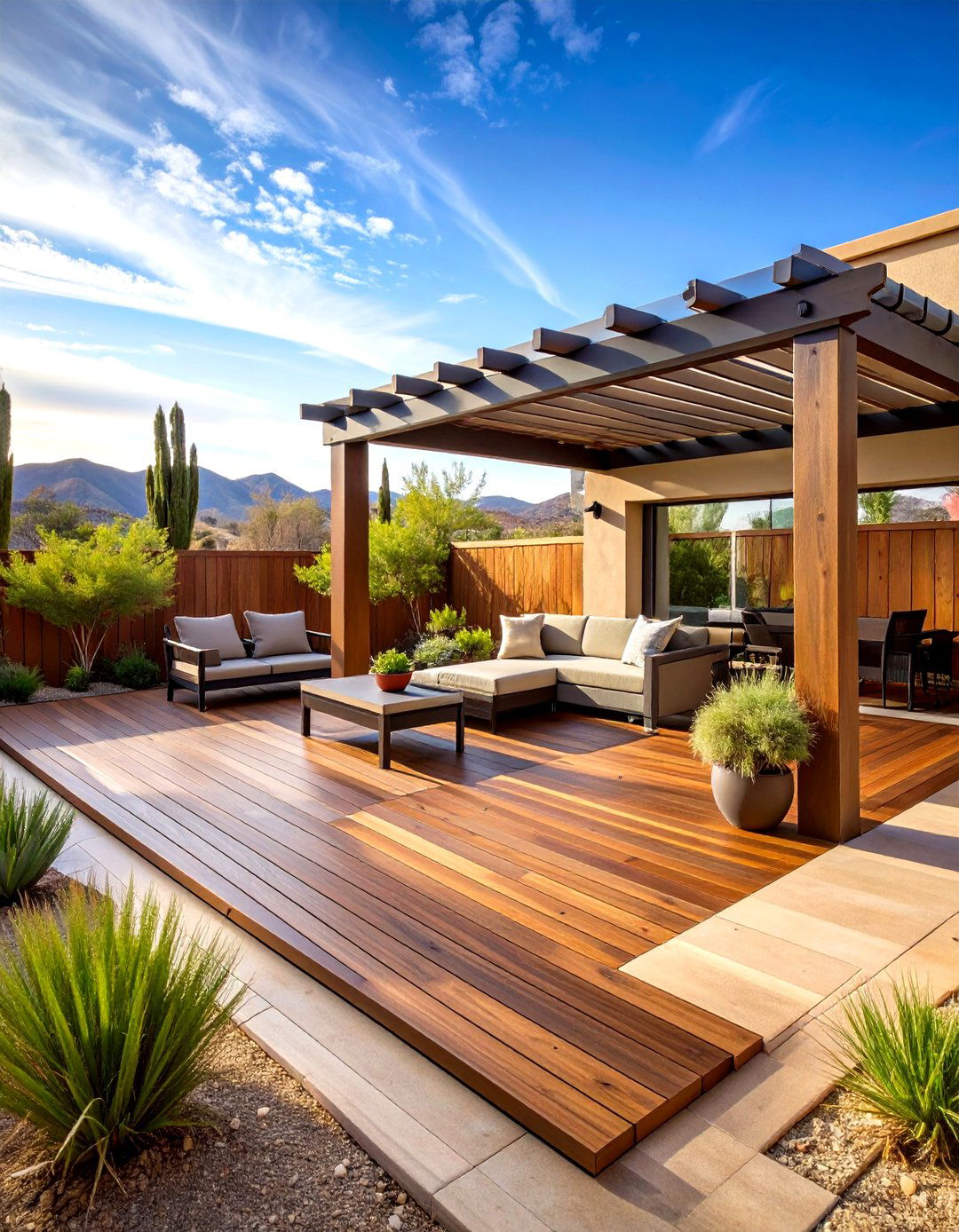
For decks that roast under desert skies, new “cool technology” composites incorporate light-reflective pigments that drop surface temps by up to 30 percent compared with darker planks, protecting bare feet and canine paws alike. Manufacturers back these boards with extended fade warranties, so colors stay true despite UV bombardment. Pair light decking with sailcloth shades or pergola slats to deepen the comfort zone, and enjoy the same soap-and-water cleanup routine as standard composites. Because pigments penetrate fully, minor scratches reveal matching color, keeping maintenance as breezy as those late-afternoon winds.
Conclusion:
Whether your heart leans toward the time-tested warmth of cedar, the futuristic durability of aluminum, or the playful flair of painted patterns, today’s deck flooring palette offers a solution for every budget, climate, and design daydream. Mix materials to create functional zones, experiment with cool-touch technologies to tame harsh sun, or lean on renewable resources like bamboo and recycled tires to tread lightly on the planet. Choose wisely, care routinely, and each board, tile, or paver will reward you with seasons of reliable footing and countless memories under open skies.


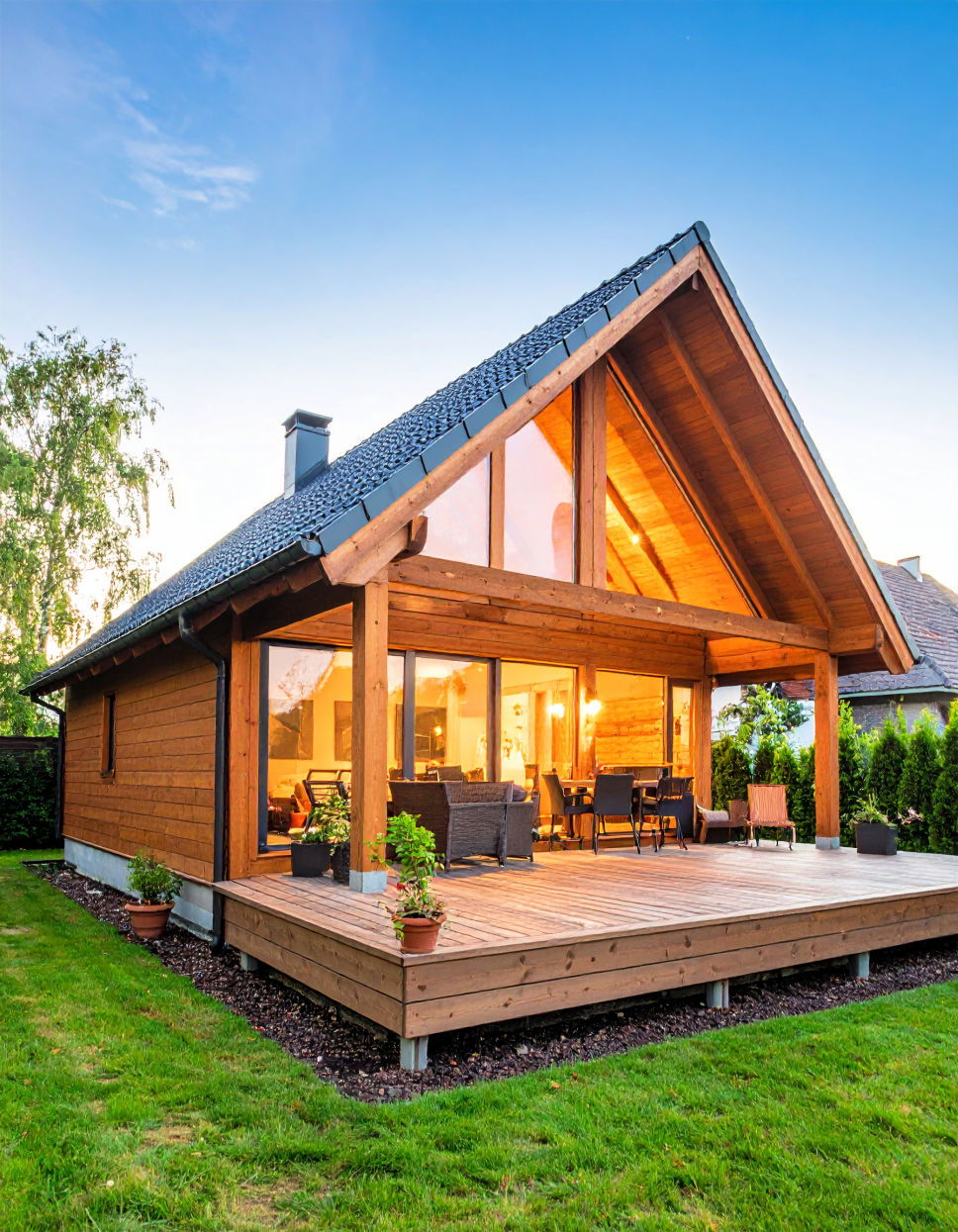

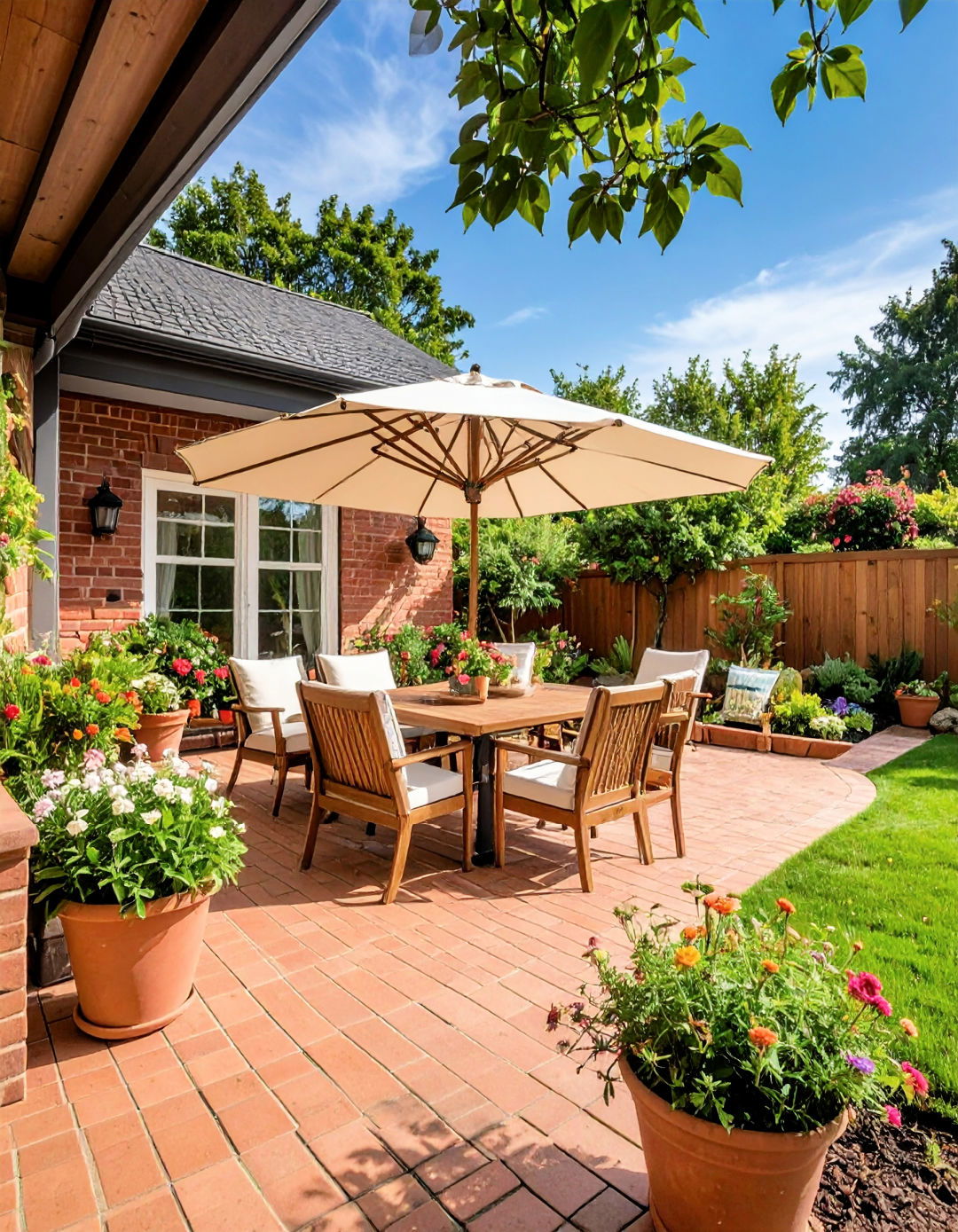
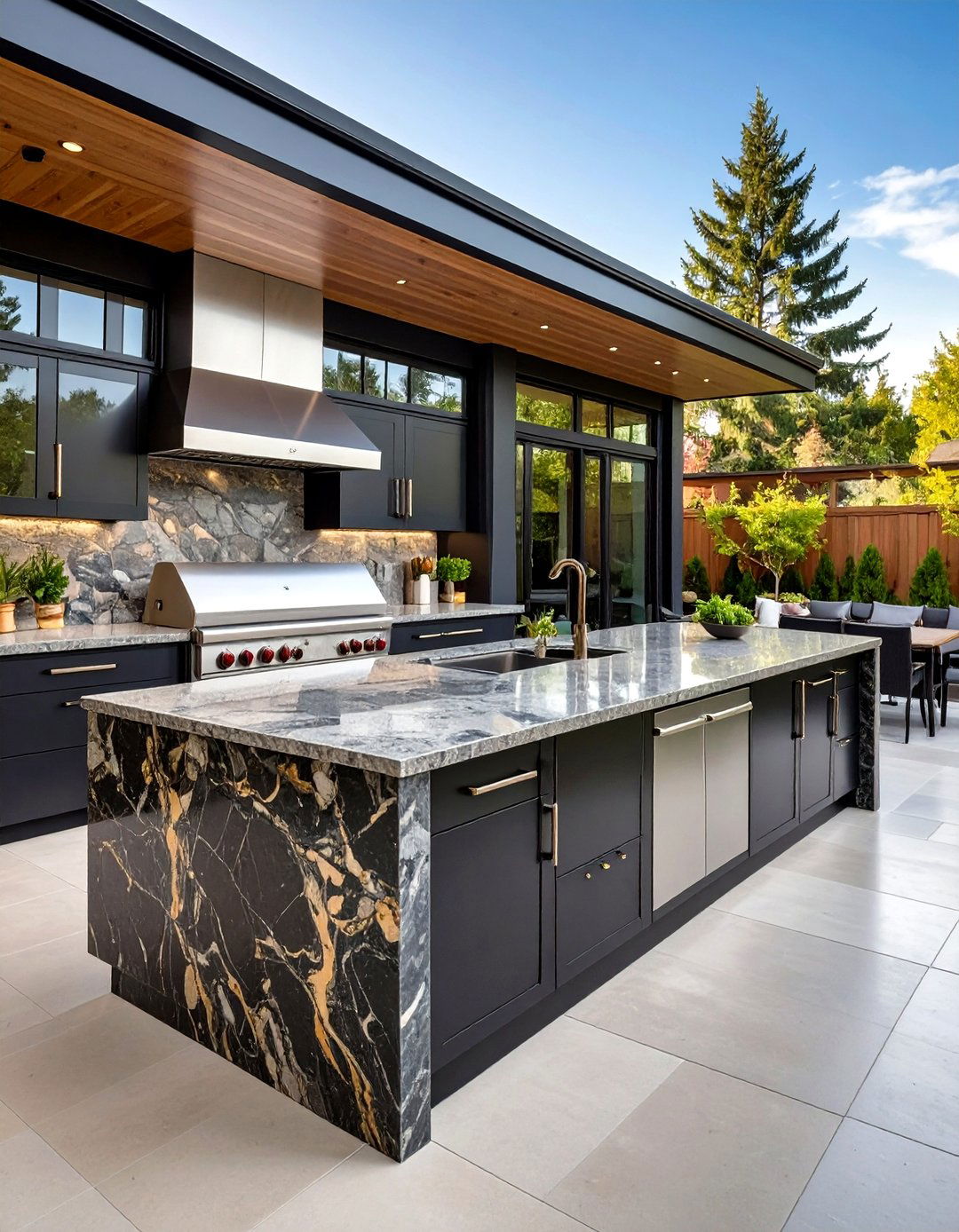
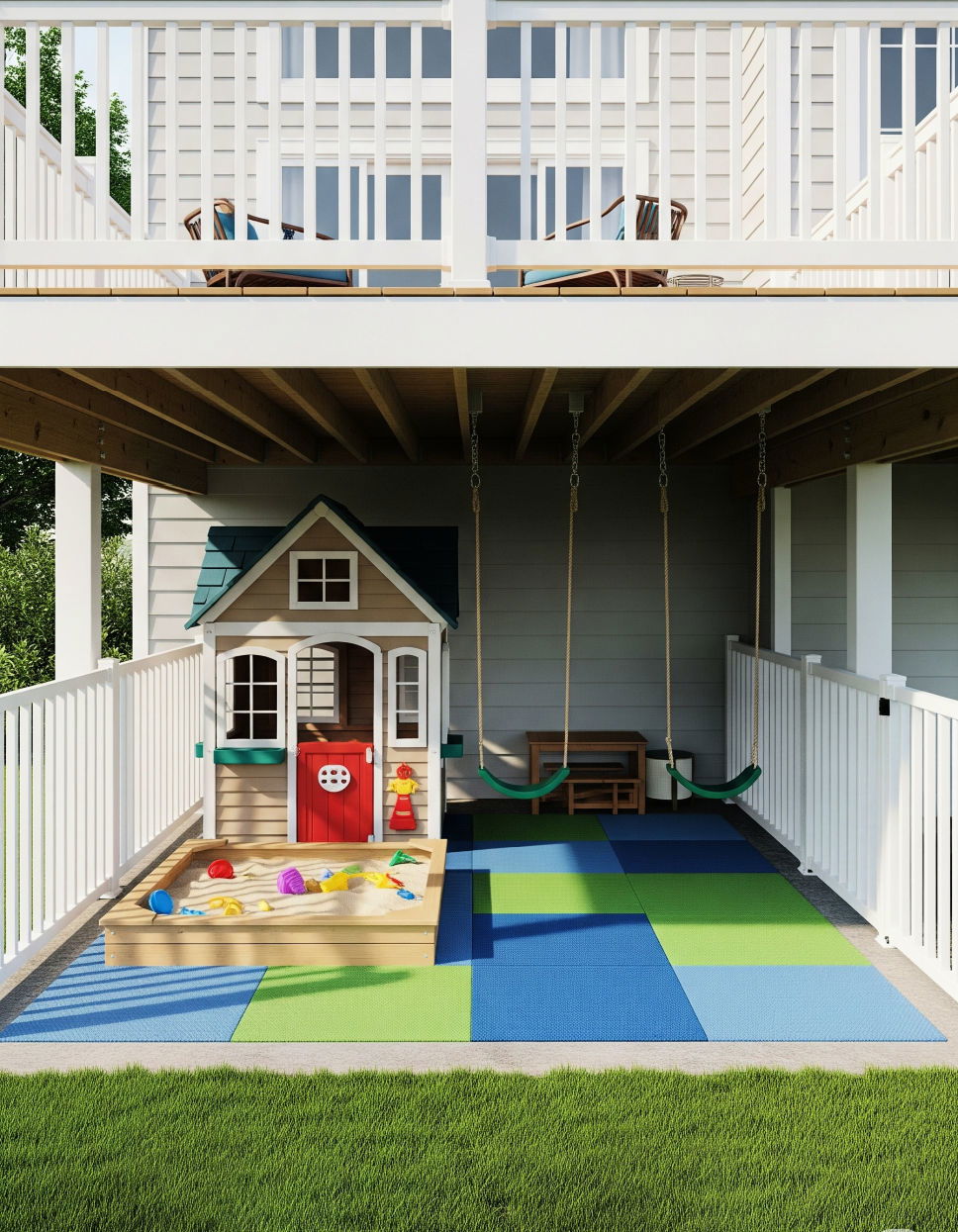

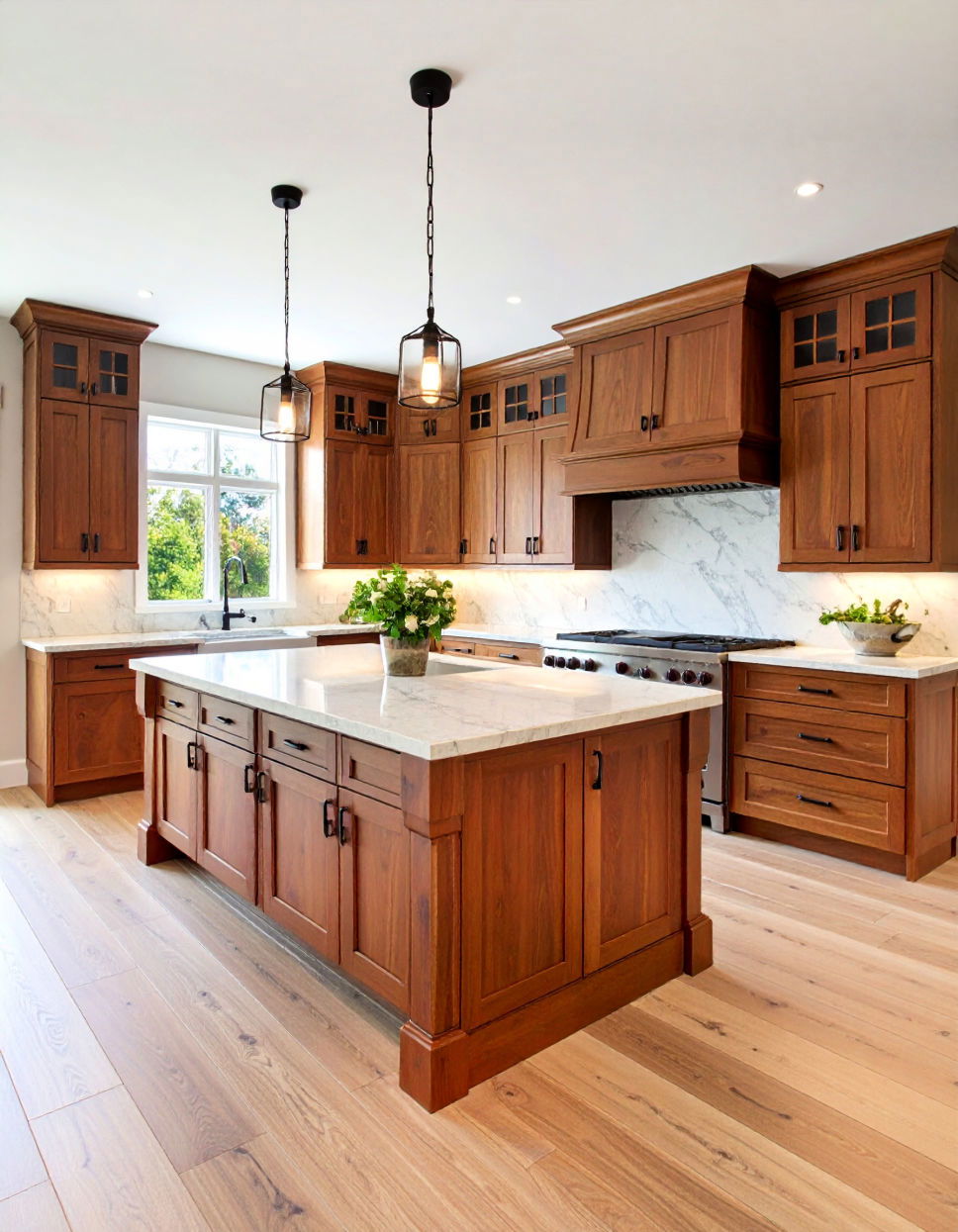
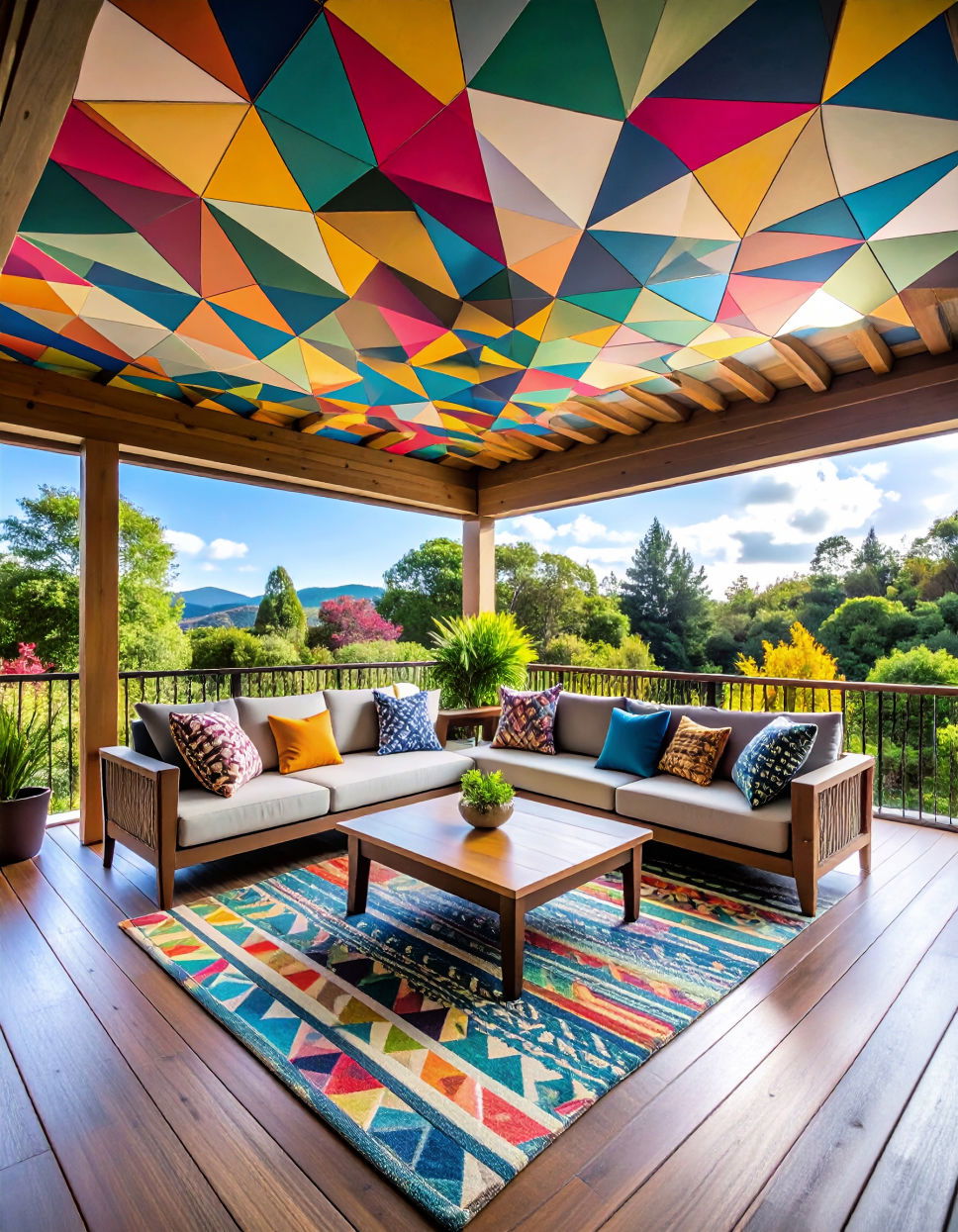

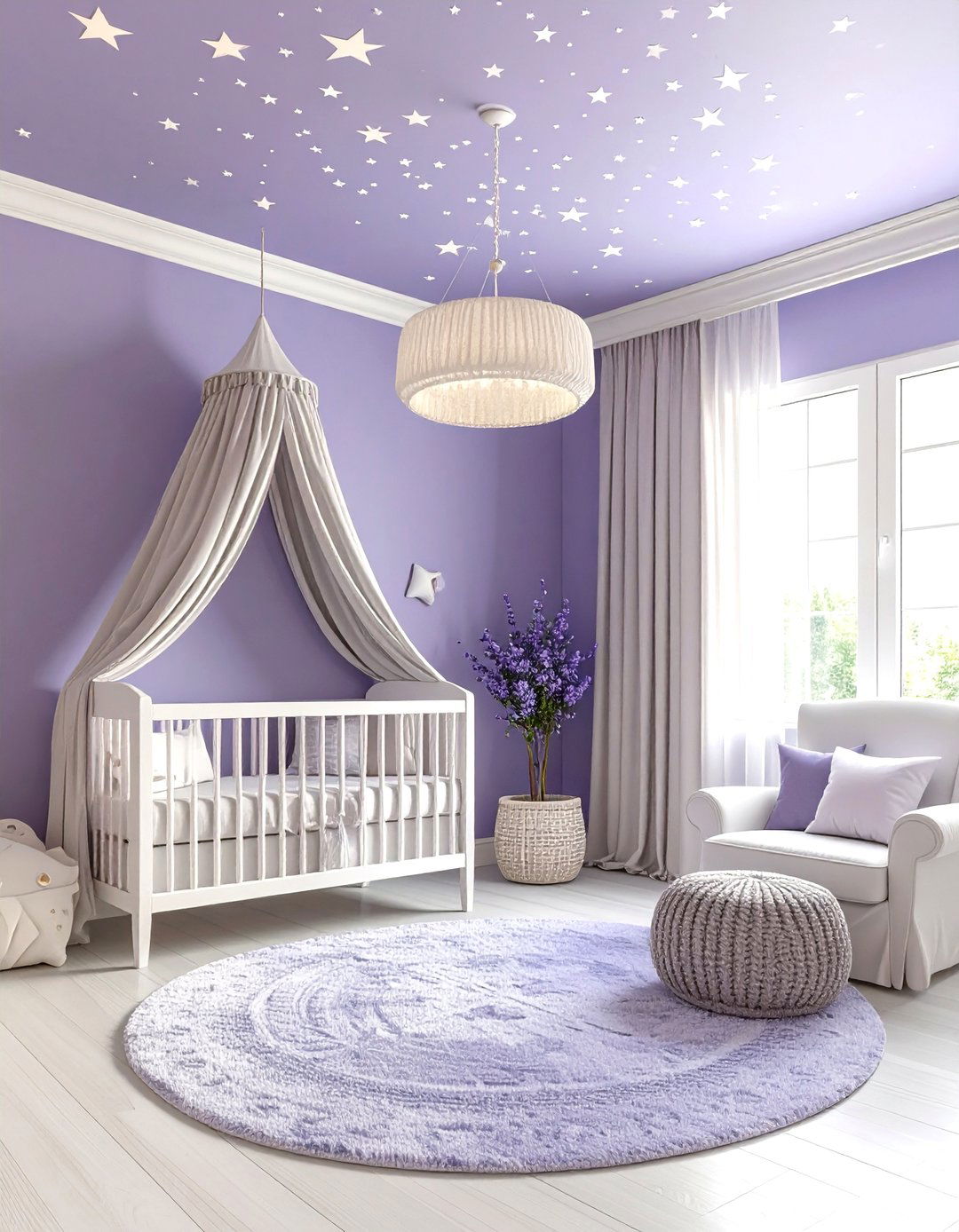
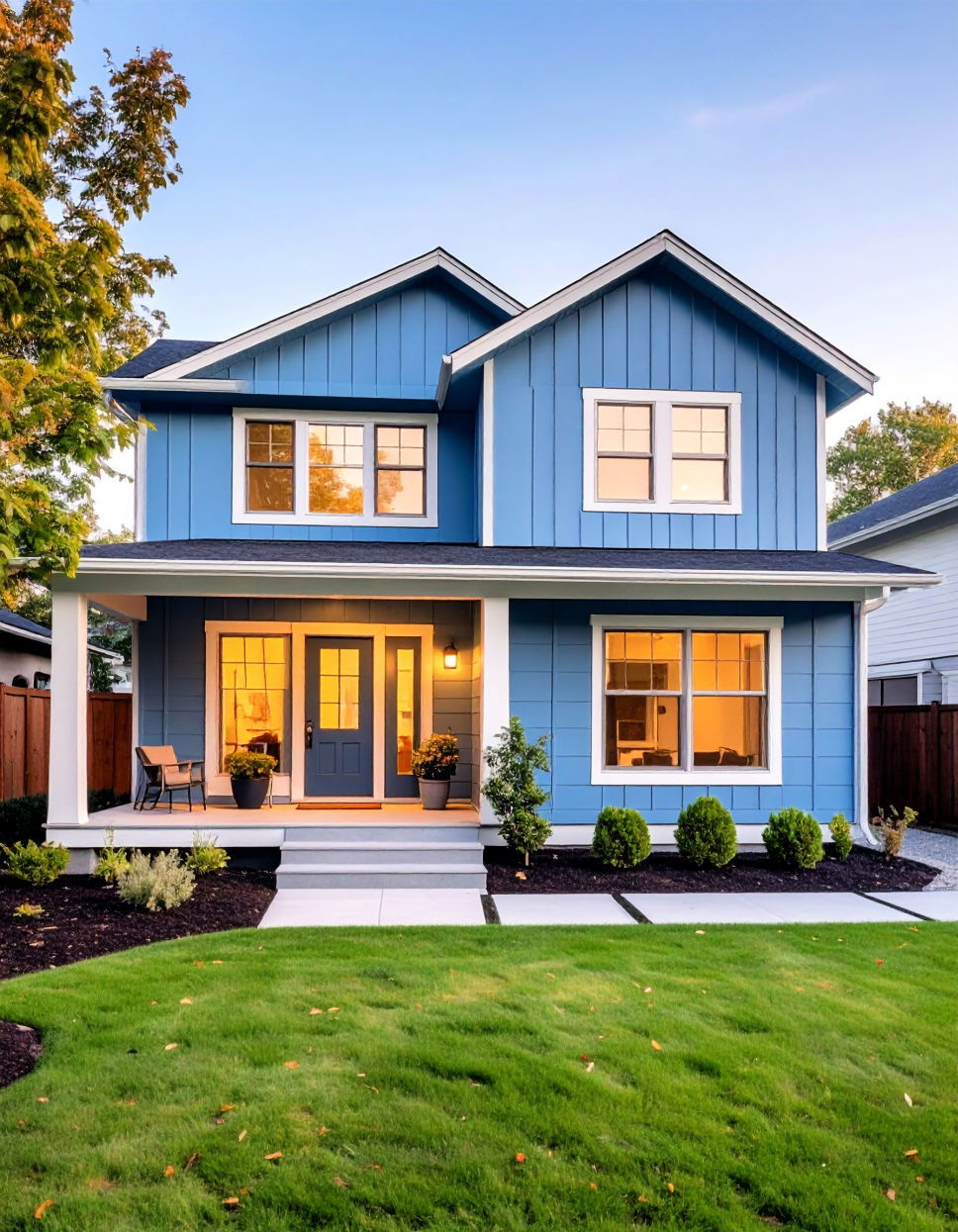

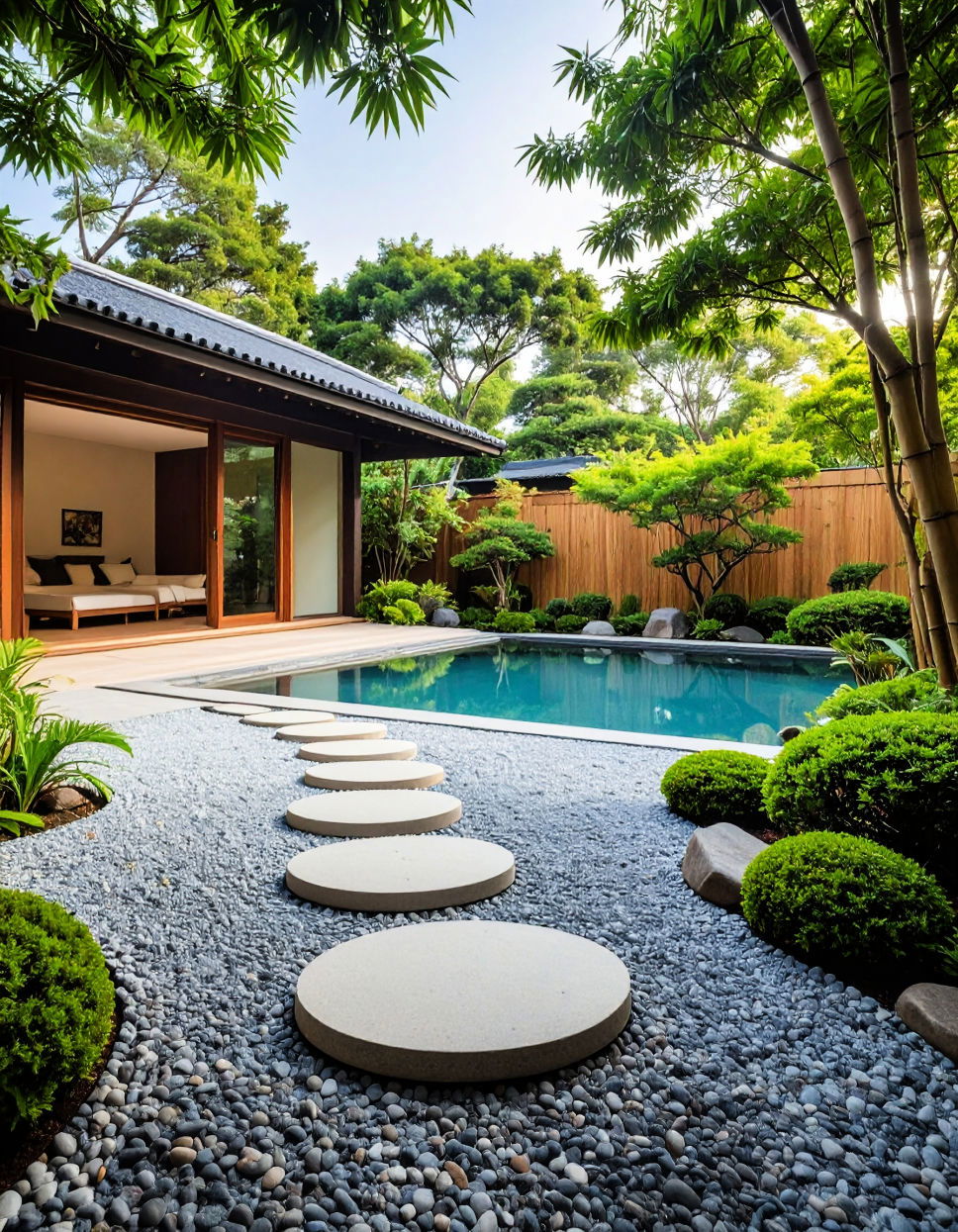
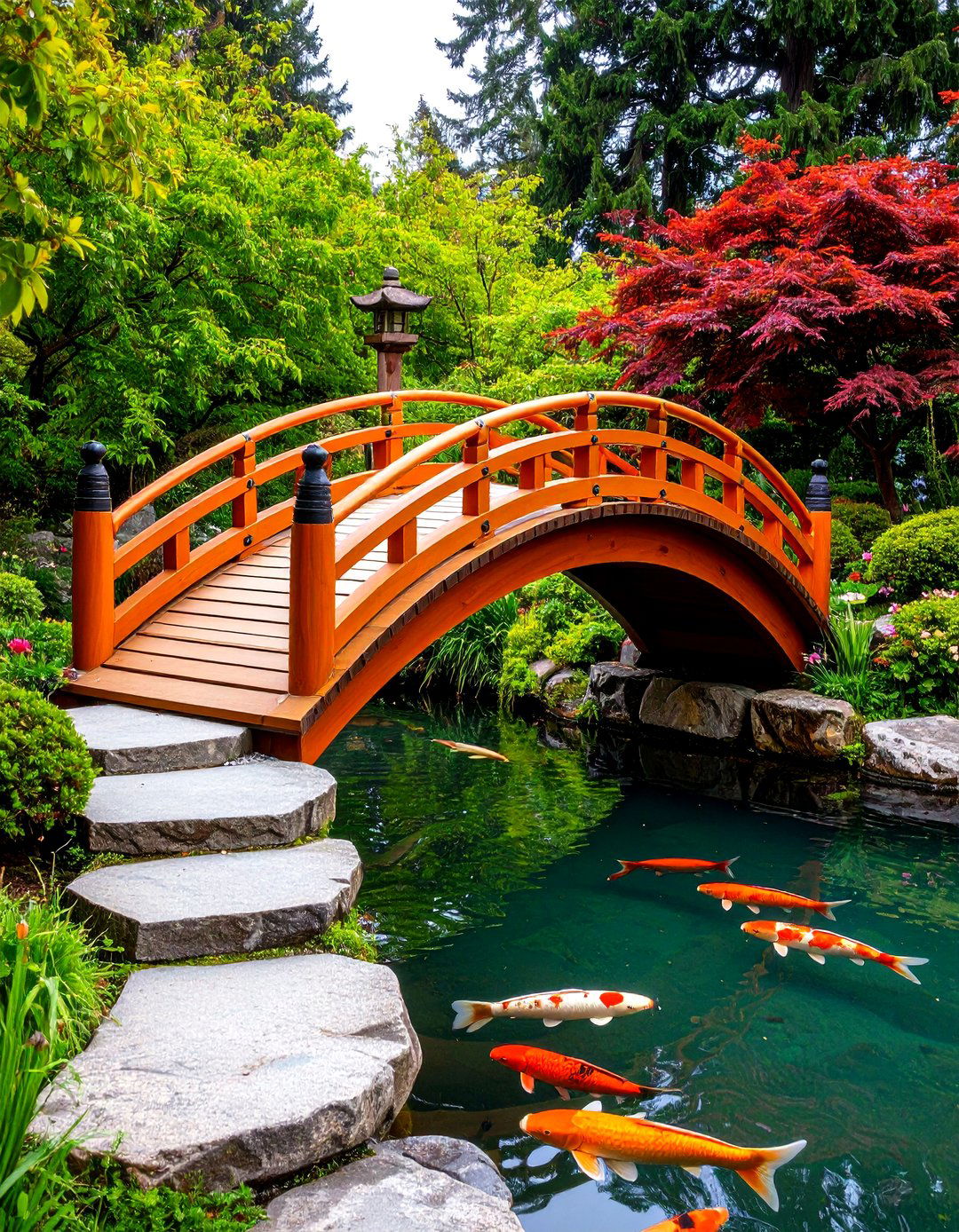
Leave a Reply